Karl Shuker's Blog, page 27
April 19, 2017
THE FRASERCOT PELTS – A VERITABLE CHINESE PUZZLE SOLVED AT LAST
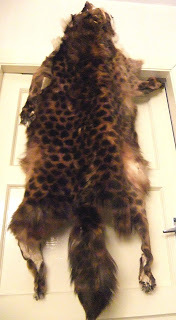 The Frasercot pelt originally owned (see Epilogue) by Mark Fraser (© Dr Karl Shuker)
The Frasercot pelt originally owned (see Epilogue) by Mark Fraser (© Dr Karl Shuker)In a short Tetrapod Zoology online blog post of 13 August 2007 (click here ), English palaeontologist Dr Darren Naish, who also has a longstanding interest in mystery animals, discussed a very eyecatching, enigmatic pelt owned by Big Cats in Britain (BCIB) founder Mark Fraser. As revealed by a colour photograph of it in his post, this most distinctive long-furred pelt sported a beautiful pattern of dark scallop-shaped markings resembling overlapping fish-scales, but which bore no resemblance to the pelage of any known mammal.
This interesting post swiftly attracted numerous responses from readers, most of whom favoured various feline identities, including king cheetah, aberrant leopard, and woolly cheetah (a freak cheetah form reported from South Africa during the late 1800s and represented by a living specimen exhibited at London Zoo during that same period), although viverrid and hyaena identities were also mooted. Alternatively, could it be a fake – but, if so, how was it done? After all, surely it would take great skill to paint a pelt so meticulously with such a detailed pattern...wouldn't it?
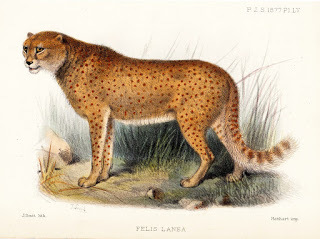 A chromolithograph from 1877 of the woolly cheetah briefly exhibited at LondonZoo at that time (public domain)
A chromolithograph from 1877 of the woolly cheetah briefly exhibited at LondonZoo at that time (public domain)In his blog post, Darren dubbed this mystifying pelt a Frasercot, in honour of its owner. He also noted that another pelt of this same type had been doing the rounds of antique fairs in Britain.
Moreover, in October 2009 Darren was in Libya, conducting some palaeontological fieldwork, and while visiting a market in Tripoli he was surprised to see a Frasercot pelt for sale there, hanging down on one of the stalls. It was too expensive for him to purchase, and in any case he was naturally concerned as to whether he would be permitted to bring such an item through customs, so he had to content himself with photographing it (a photo of it duly appeared in a Tetrapod Zoology blog article by Darren uploaded on 16 November 2009 – click here to see the photo).
Greatly intrigued by these pelts, in February 2012 I conducted some internet research concerning them. While doing so, I discovered a couple of photos of a smaller but otherwise identical pelt (alongside what looked like a second, larger one, but which was partly concealed from view by other furs) among the wares on the hand-cart of a fur vendor in Xiamen (aka Amoy), which is a major city in Fujian, southeastern China (these photos are viewable online here ). The photos had been snapped on 31 October 2006 by a professional writer (name unknown to me) hailing from Mendocino in California, USA, but based in Xiamen during that time. Under her Flickr username 'Room With A View', she had later uploaded them into one of her online Flickr albums.
Further investigations revealed that such pelts were actually from domestic dogs but had been skilfully imbued in some way with the distinctive Frasercot-style scalloping in order for the traders to pass them off as exotic big cat pelts and sell them for lucrative amounts to unsuspecting Western tourists. When I contacted Darren concerning my findings, he confirmed that he had made the same discovery in relation to the Libyan pelt. Indeed, on 15 December 2010, one of his blog's readers, with the username NaturePunk, had provided the following highly illuminating response to Darren's post regarding the Tripoli pelt, verifying my own independent findings:
This is a dog skin that has been dyed to look like a cat skin. Common thing for vendors to do in Asian countries where dogs are killed for fur. I used to see this a lot when I lived there, and they would sell the dyed pelts along with pelts which were left un-altered. They see this sort of thing all the time at the Wildlife Forensics Center in Ashland [Oregon] where I live now.
Here are some links to photos of vendors selling dog pelts on the streets, trying to convince people that they're either wolf or big cat skins, a few of which are dyed with the EXACT same patterns as the pelt pictured above [i.e. the Tripoli pelt].
One of the links provided was the same as the one that I'd also discovered (and which I've given earlier here), to the photo of the Xiamen fur vendor with the pelts. A second one was to a photo that had been snapped and uploaded onto Flickr by Tennessee-born teacher Bill Benson, now living in Tianjin, northern China. It depicted another Chinese fur vendor, this time in Dalian (a big city and seaport in northeastern China's Liaoning Province), whose hand-cart bore a fully laid-out Frasercot pelt. Unfortunately, that particular photo is no longer accessible online (but I have a copy of it on file). Apparently, the vendor had tried to pass it off to Benson as a leopard skin (which it certainly wasn't – no leopard possesses the Frasercot scalloping pattern), but Benson affirmed that it was a dyed dog skin.
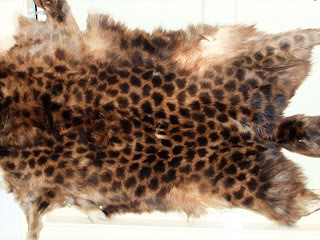 Close-up of Mark's Frasercot pelt, showing its distinctive scalloping pattern (© Dr Karl Shuker)
Close-up of Mark's Frasercot pelt, showing its distinctive scalloping pattern (© Dr Karl Shuker)Even so, I was still unclear as to the manner in which such an intricate pattern was applied to the pelts, although I wondered whether it may involve a stencil or something similar in order to produce such a precise effect.
At much the same time, I learnt from British naturalist and taxidermist Jonathan McGowan that he had included on his website ( www.thenaturalstuff.co.uk ) a photo of the Frasercot pelt that had been doing the rounds of the antique fairs - he saw it at one in Lincolnshire. Of particular interest, however, was that Jonathan was convinced that this particular pelt on which the scalloping had been applied was not from a dog but from a large cat, probably a unicoloured species such as a puma. Memorably, the stall-holder claimed that it was from a rare species that she called a fishscale leopard! On 5 March 2012, Jonathan kindly provided me with the following additional details:
The pelt I found was at the RAF Swinderby antique fair in Lincolnshire about three years ago. I at first thought it was a painted dog pelt and asked the lady if I could have a look. On doing so I noticed the short legs with typical cat like short bristly fur on the ankles. The feet were cut off unfortunately but the head was on and it had typical cat shape with leopard like ears and big long whiskers, although few in number but not like small dog whiskers. The woman said that it came from South Africa and mentioned that even the dark scales have the skin underneath also black which proves that it is real! I replied that this does indeed suggest that it is a fake as dark pigmented skin does not correspond with dark hairs. It had nothing to do with it, but looking closely at it, only a few of the scallops had dark pigment under them anyway! And when I held the fur up to the light, I could see that each individual hair was black tipped correctly with lighter underneath. If it were a fake, I wondered just why some very skilled person went to the trouble of painting every individual hair just to produce this! However I am well aware of the Chinese ingenuity in regards to faking all kinds of things. Just maybe a mutant leopard did have such scalloping fish scale spots! I don't know but it is unlikely and I would rather see it as a hoax as a genuine thing. She wanted £200 for it and I had already spent my quota for the day.
Messaging Mark Fraser online via Facebook also on 5 March concerning his Frasercot specimen, I learnt that its head was distinctly dog-like in appearance rather than cat-like, and that he had purchased it from Coventry-based taxidermy enthusiast Martin Cotterill, who in turn informed me that he had bought it several years ago from a dealer at Swinderby Antiques Fair! In other words, exactly the same fair where Jonathan subsequently saw the one that he photographed.
As Mark's pelt is dog-headed whereas the one seen by Jonathan was cat-headed, they are evidently not the same specimen, but it seems reasonable to assume that they were from the same dealer – otherwise it is a truly formidable coincidence that two such similar yet extremely unusual pelts should come up for sale at the very same antique fair. If so, does this mean that the dealer had a regular supply of them, or had merely bought the two together as a one-off purchase? Whatever the answer, the very fact that a dog-headed pelt and a cat-headed pelt exhibited precisely the same highly-unusual scalloping pattern provided, I felt, conclusive evidence that the pattern was indeed applied artificially rather than being natural.
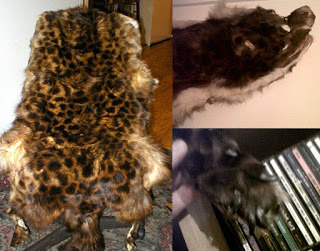 Three photos of Mark's Frasercot pelt, showing its pelt, head, and a paw (© Mark Fraser)
Three photos of Mark's Frasercot pelt, showing its pelt, head, and a paw (© Mark Fraser)Mark uploaded some photos of his pelt's head and feet onto Facebook, and these were certainly canine rather than feline in shape. On 10 March 2012, moreover, I was able to confirm this directly, as well as ascertaining its total length (55 in from nose-tip to tail-tip) when Mark very kindly sent the pelt to me on loan in order for me to examine it. I was also able to see for myself that the artistic workmanship of the applied scalloping pattern was of an extremely high standard – but the biggest surprise, and revelation, was still to come.
I showed it to my mother, Mary Shuker, who had always been very knowledgeable regarding clothes and fashion in general, and she told me straight away that she'd seen real and artificial (faux) fur coats with this same pattern in the past, and also with other exotic-looking patterns. She then took out of one of her wardrobes a faux fur jacket with an extraordinary pattern on it, totally unlike that of any real species but which, when I examined it, could be seen to have been applied in precisely the same way as the pattern on Mark's Frasercot pelt – i.e. with the pattern visible on the upper surface of the hairs but not on the undersurface.
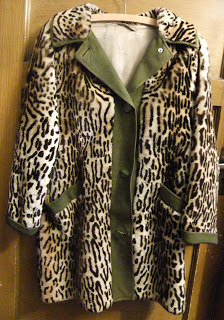 Mom's faux fur jacket exhibiting artificial patterning (© Dr Karl Shuker)
Mom's faux fur jacket exhibiting artificial patterning (© Dr Karl Shuker)Moreover, when I asked her how such a pattern could have been applied, she told me that she knew how – because the person from whom she'd bought this jacket had told her, informing her that it was applied by a machine that physically stamps the pattern onto the faux pelt using a form of heated inked plate bearing the pattern. And so, with that all-important disclosure, my mother duly solved the mystery of the Frasercot pelts!
 My mother, Mary Shuker (© Dr Karl Shuker)
My mother, Mary Shuker (© Dr Karl Shuker)Meanwhile, for absolute confirmation of its taxonomic identity, Mark had kindly given me permission to snip some sample hairs from his pelt and submit them for formal trichological examination and identification. This I did, sending them to Danish zoologist Lars Thomas, based at the Zoological Museum of the University of Copenhagen, who has considerable experience in hair analysis. And to ensure absolute objectivity during their examination, I did not provide him with any information whatsoever as to the source of the hair samples.
However, when Lars provided me with his findings, and which here on ShukerNature are now revealed for the very first time online, I was extremely surprised. This was because his initial, provisional examination of them had indicated to him that they were definitely not felid, but likely not canid either, seeming instead to be most probably of mustelid origin, and, more specifically, from the genus Mustela (containing weasels, stoats, ferrets, and polecats). Yet he was far from happy about this, because the hairs had also presented him with various anomalous features that he had not anticipated finding.
In particular, their pigment granules looked very strange, and Lars wondered if they had received chemical treatment, because a lot of the colour in outlying regions of the hairs seemed unnatural, and therefore had possibly been dyed. Moreover, he mentioned to me that chemical treatment can make pigment granules split, thus making canid or felid hairs look like mustelid hairs, because pigment granules in the latter are clearly separate, whereas they are not in canid and felid hairs.
I then provided Lars with full details of the hair samples' origin, knowing that he had heard of (but never examined) the Frasercot pelts, and I also sent him some photographs of Mark's specimen. After receiving my news and pictures, Lars then conducted a more detailed examination of the hair samples, which included sectioning one of the hairs – whereupon he discovered that it was round in cross-section. Crucially, this eliminated mustelids, because their hairs are oval or elliptical in cross-section. He also discovered that some of the hairs showed signs of heat damage and of being compressed, some of them being completely flat in very specific areas, as if they had been under pressure.
Needless to say, this would be the case if the edge of a heated stamping device had been applied to them – which in turn is exactly what my mother had described concerning the artificial application of the Frasercot patterning on fur coats that she had seen. In addition, when Lars rubbed some of the darkest hairs with ethanol and various other solvents on a Q-tip, he was actually able to rub off some of the colouring. Consequently, he informed me that he now had no doubt that the hairs had indeed been somehow artificially treated and dyed.
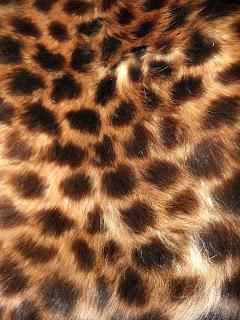 The scalloped markings of Mark's Frasercot pelt (© Dr Karl Shuker)
The scalloped markings of Mark's Frasercot pelt (© Dr Karl Shuker)An independent confirmation of his findings came unexpectedly when, while subsequently browsing online in the hope of finding further photos of Frasercot pelts, I revisited Bill Benson's Flickr albums and discovered that although his earlier-mentioned missing Frasercot pelt photo had not reappeared there, a second one was present in a different album by him. He had snapped it on 26 September 2006, and it shows an extremely large Frasercot pelt being held up by its street vendor, somewhere in eastern China (it is viewable here ). However, whereas all previous Frasercot pelts seen by me have exhibited a pristine pattern, in this one the pattern is very patchy in appearance, with certain portions faded or even entirely worn off, clearly demonstrating that it had been artificially applied. Benson affirmed again that these pelts are indeed dyed dog furs, and he also noted that poor vendors from western China come to eastern China in the hope of selling their wares.
Just as the riddle of the Frasercot pelts finally seemed solved, however, a further mystery arose concerning them. Prior to receiving the results of Lars's examination of the hair samples from Mark's specimen, I had discovered online a photograph of yet another Frasercot-patterned pelt – but crucially, unlike all previous ones encountered by me, this was not a detached pelt. Instead, it was a livedog, yet whose fur bore the characteristic fish-scale scalloping of the Frasercot pattern!
The only information accompanying this remarkable, currently unique example was that the photograph had allegedly been snapped by a Mr Richard Brooks on the Indonesian island of Bali. I have spent considerable time trying to trace Mr Brooks, but all to no avail. And so, due to its great significance to the subject in hand, I'm including a small, low-resolution version of his photo here on a strictly Fair Use, educational, non-commercial basis only, acknowledging fully that Mr Brooks is its copyright holder.
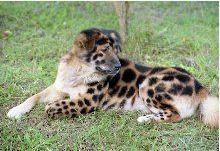 Live dog allegedly on Bali exhibiting Frasercot fur pattern (© Richard Brooks – reproduced here in low-resolution format on a strictly non-commercial, educational, Fair Use basis only; despite considerable attempts, I have so far been unable to trace Mr Brooks)
Live dog allegedly on Bali exhibiting Frasercot fur pattern (© Richard Brooks – reproduced here in low-resolution format on a strictly non-commercial, educational, Fair Use basis only; despite considerable attempts, I have so far been unable to trace Mr Brooks)Of course, in this age of readily-available photo-manipulation techniques, it needs to be stressed here that the worrying possibility of this photograph actually being the result of one such process cannot be ruled out, especially as its supposed originator has so far resisted all attempts to be traced and his name may therefore be fictitious, just a pseudonym.
What makes this living Frasercot-patterned canine specimen so fascinating if indeed genuine, however, is that clearly its pattern could not have been applied to it by a mechanical, heat-stamping device. So as the Frasercot pattern is of artificial, man-made design, it must have been applied to the dog's fur by being painstakingly painted upon it, and surely with the dog fully anaesthetised while this very delicate process was being performed (having said that, the spots on this live dog are rather bigger than those on all Frasercot pelts currently recorded, so it would have been less difficult to apply them to it).
The obvious question to be asked here is why anyone should wish to perform such an elaborate form of decoration upon a live dog anyway. But perhaps its Frasercot-adorned coat made it valuable or much sought-after as a pet, or even for sale as an exotic 'rare breed' to some unsuspecting tourist, and it is certainly not the first time that I have seen domestic animals with intricately-embellished coats.
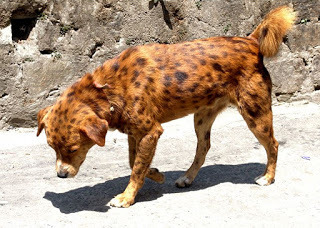 Dog with fake spots in Kalimpong, West Bengal, India (© Sukanto Debnath/Wikipedia –
CC BY 2.0 licence
)
Dog with fake spots in Kalimpong, West Bengal, India (© Sukanto Debnath/Wikipedia –
CC BY 2.0 licence
)For instance, there are photos of many different examples online involving dogs, including tiger-striped, leopard-spotted, and even black-and-white giant-panda-rendered versions (utilising chows - click here for photos). Also, while visiting Tijuana, Mexico, in 2004 I saw one of the famous 'Tijuana zebras' – in reality, donkeys that have been painted with stripes in order to look like zebras – being used for photo sessions with tourists.
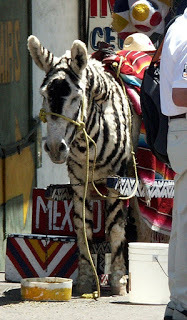 One of Tijuana's famous 'zebras' – in reality a donkey with painted-on stripes (public domain)
One of Tijuana's famous 'zebras' – in reality a donkey with painted-on stripes (public domain)So it would seem that after perplexing cryptozoologists and mainstream zoologists alike for many years, the mystifying Frasercot pelts are finally a (Chinese) puzzle no longer.
My sincere thanks to Mark Fraser, Lars Thomas, Dr Darren Naish, Jonathan McGowan, Martin Cotterill, and above all my late mother Mary Shuker for their greatly valued contributions to my Frasercot investigations; and additionally to Mark for so kindly loaning to me his Frasercot pelt for examination.
EPILOGUE – 19 April 2017
Today I discovered here that Mark's Frasercot pelt was sold on the internet auction site Ebay UK on 28 June 2014, but at present I have no further details concerning this transaction or its new owner/whereabouts.
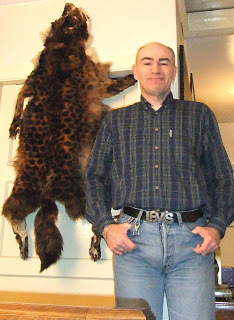 Photographed alongside me for scale purposes (I stand 5'10" tall) while on loan to me during March 2012, the Frasercot pelt then-owned by Mark Fraser (© Dr Karl Shuker)
Photographed alongside me for scale purposes (I stand 5'10" tall) while on loan to me during March 2012, the Frasercot pelt then-owned by Mark Fraser (© Dr Karl Shuker)
Published on April 19, 2017 11:21
April 12, 2017
THE WARRACABA TIGER AND OTHER SOUTH AMERICAN PACK-HUNTING MYSTERY CATS
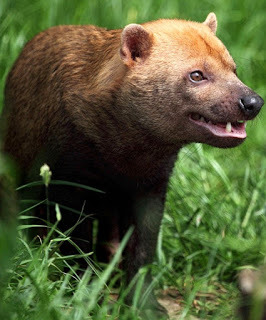 Bush dog (public domain)
Bush dog (public domain)According to native Indian testimony, as well as that of certain Western explorers and cryptozoological investigators, South America is home to several different types of mysterious, scientifically-unidentified cat that are very distinct from one another morphologically but which are reputedly united by a single characteristic that if genuine is highly unusual for jungle-dwelling felids – for they supposedly hunt in packs, like dogs. Indeed, so unusual do these ostensibly canine cats seem that, as will be revealed here, some authorities have suggested that perhaps they truly are canids, and not felids at all. (And for another South American mystery cat that may in reality be a dog, click here to read my ShukerNature article re the mitla)..
TRUMPETING ABOUT GUYANA'S FEROCIOUS WARRACABA TIGERSThe warracaba (or waracabra) tiger, as it is known to the Guyanan natives, differs from the typical jaguar (called 'tigre' by Hispanics here) in an extremely significant way with respect to behaviour. For whereas the recognised jaguar Panthera onca (whether spotted or black) is a solitary hunter, Guyana's elusive warracaba tiger allegedly hunts in packs, which in turn may contain dozens of individuals. Needless to say, any felid that hunted in this manner would be a very special kind of cat indeed.
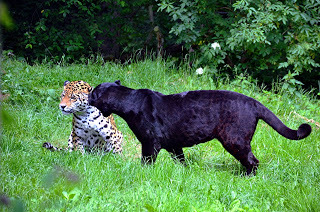 Normal spotted jaguar with black (melanistic) jaguar (public domain)
Normal spotted jaguar with black (melanistic) jaguar (public domain)Not surprisingly, therefore, the warracaba tiger has attracted considerable interest from travellers to Guyana. In an Animal Kingdom periodical article from 1957, the eminent American naturalist and author William Bridges incorporated an impressive series of reports concerning this animal, dating back to the end of the 19th Century (oddly, modern-day reports are all but non-existent). These include the following selection.
In his book Twenty-Five Years in British Guiana, published in 1898, Henry Kirke, a former Sheriff of Demerara, noted:
There is a mysterious beast in the forest called by the native Indians the "waracabra tiger." All travellers in the forests of Guiana speak of this dreaded animal, but strange to say, none of them appear to have seen it. The Indians profess the greatest terror of it. It is said to hunt in packs (which tigers [jaguars] never do), and when its howls awake the echoes of the forest, the Indians at once take to their canoes and wood skins as the only safe refuge from its ravages.
Indeed, this was precisely the action taken by Indian attendants of British explorer C. Barrington Brown upon hearing (though not seeing) the approach of one such pack in an incident occurring at the edge of Guyana's Curiebrong River during the mid-1800s. On this occasion, a single boat was used as the means of escape, which Brown boarded too. Enquiring the nature of these evidently much-feared felids, Brown was informed by the Indians that they were small but exceedingly ferocious tigers; that they hunted in packs; and that they were not frightened by camp fires or anything except the barking of dogs. Upon crossing the river, however:
...a shrill scream rent the air from the opposite side of the river, not two hundred yards above our camp, and waking up echoes in the forest, died away as suddenly as it rose. This was answered by another cry, coming from the depths of the forest, the intervals being filled up by low growls and trumpeting sounds, which smote most disagreeably on the ear. Gradually the cries became fainter and fainter, as the band retired from our vicinity, till they utterly died away.
Brown remarked that these beasts' cry resembled that of the waracabra bird (better known as the grey-winged trumpeter Psophia crepitans, a predominantly glossy-black relative of the cranes, coots and bustards), hence the name 'waracabra tiger'. These latter mystery animals are called y'agamisheri by the Accawoio Indians, who state that they vary in both size and colour and that as many as a hundred individuals can constitute a single pack. Little wonder that Brown's Indian companions were so desperate to depart. The prospect of meeting up with a hundred or so jaguars (even under-sized ones) all at once would surely daunt even the most courageous of human hunters!
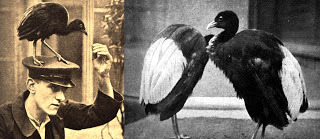 Vintage photos of trumpeters (public domain)
Vintage photos of trumpeters (public domain)In Among the Indians of Guiana, published in 1883, author and explorer Sir Everard F. im Thurn alleged that he had actually encountered three warracaba tiger eyewitnesses but admitted that it was clear that the tale related by one of them was much exaggerated. Im Thurn also offered his own suggestion concerning these fabled felids, that reports of them had taken their roots from the fact that puma families occasionally travel together.
During the early part of the 20th Century, Lee S. Crandall, who went on to become the General Curator of New York's Bronx Zoo, spent time working in Guyana and encountered many reports of the warracaba tiger. Once again, however, he never met an Indian who affirmed unequivocally that he had not merely heard but had also actually seen any of these mysterious creatures. This latter aspect is a frequent but notably perplexing component of warracaba tiger reports - the creatures are heard but never seen.
Consequently, as a solution to the mystery of the warracaba tiger and especially to this notably strange facet of their case history, Crandall proposed the following elegant explanation. Namely, that this beast was not a special form of jaguar at all; instead, it was simply some animal species that hunted in packs at night, yet which voiced such terrifying sounds whilst doing so that no Indian had ever been brave enough to investigate the identity of these sounds' originators - as a result of which they had never realised that this aurally abhorrent creature was in fact already known to them by sight during the daytime.
Crandall even named the species that he felt was responsible - an animal that is neither jaguar nor, in fact, any form of felid, but is one of South America's most unusual species of wild dog. Namely, the bush dog Speothos (formerly Icticyon) venaticus, a very curious, little-known canid not closely related to other species.
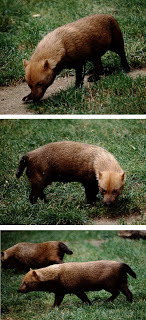 Bush dogs (© Dr Karl Shuker)
Bush dogs (© Dr Karl Shuker)Measuring no more than 3 ft in total length and a mere 1 ft in shoulder height, in colour it is dark reddish-brown dorsally and virtually black ventrally (rather rare amongst non-melanistic mammals). The bush dog's distribution extends from Panama and Colombia to northern Venezuela, Brazil, Guyana, Surinam, French Guiana, northernmost Ecuador, eastern Peru, northern Bolivia, and Paraguay. According to certain reports, it does hunt in packs (indeed, it may spend its entire life in packs), but in general behaviour is exceedingly secretive.
Worth noting was the impression by botanist Dr Nicholas Guppy (who had spent much time in Guyana) that, whereas the older Indians still believe that packs of warracaba tigers exist in the more remote mountainous regions, the younger Indians seem more disposed to believing the Western identification of them as bush dogs.
And certainly, as far as its distribution, hunting behaviour, and general elusiveness are concerned, the bush dog does compare favourably with the legendary warracaba tiger (and, as the latter is not normally seen, morphological comparisons are superfluous). Conversely, the famous hideous scream of the warracaba tiger contrasts sharply with the relatively feeble whine voiced by bush dogs. Also, it is rather difficult to believe that the Guyanan Indians, frightened or not, could really confuse - visually and/or aurally, singly and/or in packs - a bush dog with any form of jaguar. The mystery of the warracaba tiger may not be solved after all.
PACK-HUNTING MYSTERY FELIDS OF PERU AND ECUADOR
The most obscure pack-hunting crypto-cats reputedly inhabiting South America, however, are those that have been variously reported from Peru and Ecuador.
During the 1990s, Peru-born zoologist Dr Peter Hocking collected native reports concerning a number of mystifying cat forms allegedly existing in Peru but which are not known to science. One of these is the so-called 'jungle wildcat', reported from montane forests in the lower Urubamba River valley. Apparently, it is no larger than an average domestic cat, is patterned in a varied assortment of blotches, and has noticeably long fangs. Far more distinctive, however, is its apparent proclivity for hunting in packs, containing ten or more individuals.
While visiting southern Ecuador's Morona-Santiago province in July 1999, Spanish cryptozoologist Angel Morant Forés learnt of several mystery cats said to inhabit this country's Amazonian jungles. Upon his return home, he documented them in an online field report, entitled 'An investigation into some unidentified Ecuadorian mammals', which he uploaded in autumn 1999 onto French cryptozoologist Michel Raynal's website, the Virtual Institute of Cryptozoology, and from where I downloaded a copy of it (fortunately, as it turned out, because, like so often happens in the ephemeral world of cyberspace, it now seems to have vanished). These very intriguing crypto-felids included two different alleged pack-hunting forms.
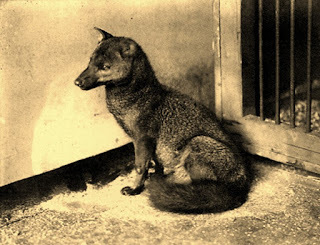 Vintage photograph from 1913 of a captive small-eared dog (public domain)
Vintage photograph from 1913 of a captive small-eared dog (public domain) One of them is the tsere-yawá, which is also said by the native tribes to be semi-aquatic. Angel was informed that this 3-ft-long felid hunted in packs of 8-10 individuals, and was brown in colour, like the brown capuchin monkey whose local name, tsere, it shares. In 1999, a young man named Christian Chumbi from Sauntza allegedly saw eight of these cats less than 50 ft away in the river Yukipa. Unfortunately, there are insufficient morphological details available to attempt any taxonomic identification of this mystery felid.
Interestingly, the small-eared dog or zorro Atelocynus microtis, a surprisingly cat-like wild dog, inhabits Ecuador, and is known to be semi-aquatic – it even has partly-webbed feet. So might this reclusive canid species. already proposed elsewhere by me as an identity for a feline mystery mammal called the mitla (click here ), once again be in contention as the true identity of a supposed crypto-cat?
Alternatively, otters are social creatures, so could the tsere-yawá actually turn out to be lutrine rather than either feline or canine? Indeed, one South American species, the marine otter Lontra felina, is so feline in outward mien that it is even referred to colloquially as the sea cat (it is predominantly coastal in distribution but will sometimes enter rivers in search of freshwater crustaceans). The other three species of South American otter currently known to science are the neotropical river otter L. longicaudis, the southern river otter L. provocax, and the aptly-named giant otter or saro Pteronura brasiliensis.
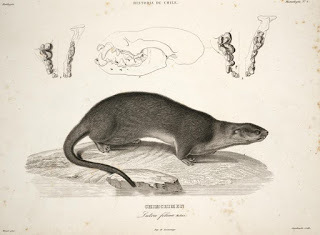 An 1848 illustration of the marine otter or sea cat Lontra felina (public domain)
An 1848 illustration of the marine otter or sea cat Lontra felina (public domain)The second Ecuadorian feline pack-hunter is known as the jiukam-yawá. As Angel was only able to collect second-hand reports of it, not personal eyewitness accounts, however, he declined to document this cryptid in his field report.
With so little in terms of morphological details to analyse, the supposed pack-hunting felids of Peru and Ecuador currently remain enigmatic to say the least. However, should any zoologist with cryptozoological interests be visiting either or both of these South American countries on official research business at some stage in the future, they should consider devoting some of their spare time there to the questioning of local inhabitants concerning the above mystery cats(?), in the hope of obtaining additional details.
After all, when dealing with creatures as paradoxical as pack-hunting mystery cats – not to mention a semi-aquatic cat! – every snippet of information procured is a major bonus that may conceivably shed much-needed light upon these baffling beasts' identities.
See also my books Mystery Cats of the World and Cats of Magic, Mythology, and Mystery .
[image error]
Published on April 12, 2017 05:37
April 8, 2017
SEEKING THE SANDWELL VALLEYGATOR!
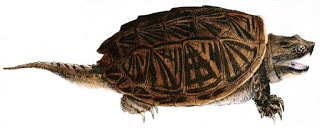 North America's common snapping turtle, from John Edwards Holbrook's book North American Herpetology (1842) (public domain)
North America's common snapping turtle, from John Edwards Holbrook's book North American Herpetology (1842) (public domain)It may be the town in which I was born, but West Bromwich in the West Midlands, England, is more readily associated with football, courtesy of West Bromwich Albion FC, than cryptozoology - until the Sandwell Valleygator came on the scene, that is, as now recalled in this ShukerNature retrospective.
Also nicknamed the Sandwell Snapper in early media accounts and initially likened to a crocodile, caiman, or alligator, this elusive aquatic cryptid first reared its snouted head on 30 March 1999. That was when fisherman Mike Sinnatt saw what he initially thought to be "a marvellously shaped piece of wood", measuring over 2 ft long, suddenly come alive and attempt to seize an unsuspecting Canada goose on Swan Pool.
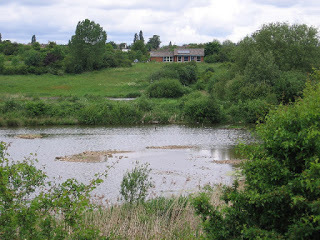 Partial view of Sandwell Valley RSPB Reserve (© Bill Payer/Wikipedia -
CC
BY-SA 2.0 licence
)
Partial view of Sandwell Valley RSPB Reserve (© Bill Payer/Wikipedia -
CC
BY-SA 2.0 licence
)Situated in an RSPB (Royal Society for the Protection of Birds) reserve within the Sandwell Valley Country Park - a verdant oasis for nature right in the heart of urbanised West Brom - Swan Pool measures more than a mile in circumference, and is not only inhabited by a rich variety of waterbirds but also is popular for angling, yachting, and wind-surfing.
Or at least it was until, within a short time of Sinnatt's sighting, a dozen other similar reports had surfaced, all describing a fairly sizeable four-legged aquatic beast with a notable snout, long tail, and a penchant for snapping at anything avian or piscean that came too near. Eyewitnesses included local angler Tony Price and pool lifeguard Ricky Downes, who spied its two "very chunky" hind legs and tail.
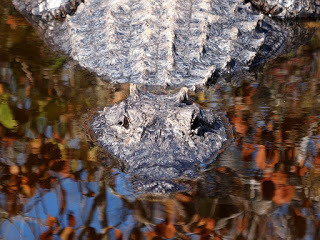 Was an alligator lurking in the Sandwell Valley?? (public domain)
Was an alligator lurking in the Sandwell Valley?? (public domain)Occurring so close to the beginning of April, the Sandwell Valleygator was originally dismissed by sceptics as a hoax, but this was strenuously denied by Sandwell Council, who were so concerned about the potential danger posed to the general public by the creature that they closed the pool to all watersports throughout the Easter Bank Holiday (3-6 April 1999). Needless to say, however, the considerable media publicity generated not only locally but also nationally and even internationally by Swan Pool's stealthy snapper resulted in a massive influx of visitors here (estimated at more than 9,000) during the Bank Holiday, all eagerly scanning the reed beds and shallows in search of its cryptic alligatorian (or crocodilesque?) interloper.
As I deemed it highly unlikely that the creature would appear when confronted by such a barrage of human activity, however, I waited until the holiday period was over before visiting Swan Pool myself. Walking around this sizeable lake, peering at the large island present at its centre, at the smaller pools and marshes fringing its border, and down into its murky depths, it swiftly became evident that an aquatic creature of the proportions described by the Valleygator's eyewitnesses could live out a secluded, rarely-spied existence here indefinitely.
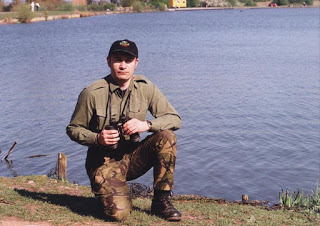 I’m keeping a sharp lookout for the Sandwell Valleygator! (© Dr Karl Shuker)
I’m keeping a sharp lookout for the Sandwell Valleygator! (© Dr Karl Shuker)Yet although neither the Valleygator itself nor any convincing reports of it surfaced during the Bank Holiday or my own subsequent visit, official opinion as to its identity had by now veered away from the scenario of a vicious snap-happy crocodile, caiman, or suchlike to the rather more placid scenario of a giant salamander. Specifically, the North American hellbender Cryptobranchus alleganiensis, which measures up to 30 in long, subsists upon small animal life such as frogs, fishes, snails, crustaceans, and insect larvae, and is native to the eastern United States.
Such a beast could certainly survive, therefore, in the prey-filled, temperate waters of Swan Pool. However, the fatal flaw in this otherwise promising proposal is that unlike certain crocodilian species the hellbender is hardly ever maintained in captivity by private individuals, especially in Britain. So the chance of one having escaped (or been deliberately released) and taken up residence in Swan Pool is extremely remote.
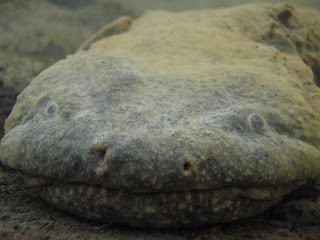 Head-on with a hellbender (public domain)
Head-on with a hellbender (public domain)On 7 April, Swan Pool was formally re-opened, with the Sandwellmander, as it had by now been redubbed in media accounts, no longer deemed to pose a risk to watersport enthusiasts. Or, to quote from a local newspaper report the optimistic words of Sandwell's senior countryside ranger Roy Croucher: "We have decided to re-open the pool on the basis that this thing is not going to leap out of the water and grab someone around the throat".
Less than a week later, however, an unexpected water beast did make an appearance - a North American common snapping turtle Chelydra serpentina, discovered sunbathing on a marsh close to Swan Pool. As its name suggests, this belligerent, sturdy species of freshwater tortoise is famous for snapping viciously, possesses a prominent snout, a long tail, and can grow up to 2 ft long (its close relative the alligator turtle can reach lengths of almost 3 ft). Hence it exhibits the very same features consistently described by eyewitnesses of the Swan Pool mystery beast. Moreover, in sharp contrast to the hellbender, the snapping turtle is commonly kept by amateur herpetologists, so an escapee (or even a deliberately released) specimen of this species turning up here is by no means implausible.
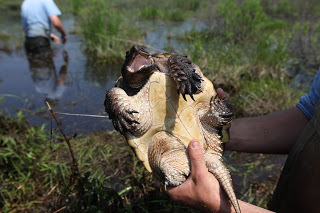 Handle with care! A common snapping turtle (public domain)
Handle with care! A common snapping turtle (public domain)All of which only adds, therefore, to the mystery of why, or how, an unnamed Sandwell Council spokesman could confidently state in subsequent media accounts that this captured snapping turtle was not the elusive Swan Pool cryptid. How did he, or anyone else, know? Snapping turtles are readily able to walk on land, so one could easily have made its way back and forth between Swan Pool and any of the neighbouring marshes
In late July 2001, moreover, a notable sequel occurred - the netting in Swan Pool of an 18-in-long American common snapping turtle, weighing in at a hefty 4 lb. Captured alive but in a distinctly irate state by teenager Harry Billingham, assisted by his stepdad Mark, Harry's brother Jack, and friend Dean Cooke, the aggressive reptile was swiftly brought to the attention of the local RSPCA office by its astonished captors.
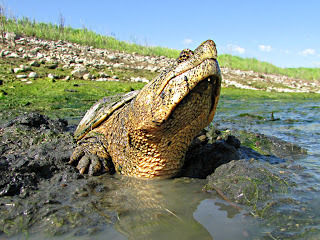 A snapper rises to the occasion (public domain)
A snapper rises to the occasion (public domain)As this species is not native to Britain or anywhere else in Europe, the Swan Pool specimen must have been abandoned there by someone, no doubt when it was much smaller - hence quite some time ago, and possibly far back enough for it to have been responsible for the 1999 Sandwell Valleygator flap? Perhaps, when some initial media accounts nicknamed it the Sandwell Snapper, they were closer to the truth than anyone realised.
Further support for this identity as a plausible solution to the Valleygator mystery was obtained on 18 July 2003, when a second sizeable adult American common snapping turtle, sporting a shell diameter of 14 inches and believed to be up to 20 years old, was snared in another West Midlands pool, this time one just north of Slacky Lane in Walsall. As for the Valleygator itself, meanwhile, nothing more has been seen or heard of it, so one or both of the above-mentioned snappers captured respectively near to or at Swan Pool may indeed have been responsible for those pre-Easter sightings of it back in spring 1999. Then again...
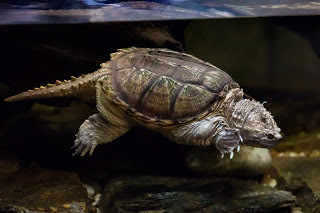 A snapper seen underwater (© Manfred Werner/Wikipedia
CC BY-SA 3.0 licence
)
A snapper seen underwater (© Manfred Werner/Wikipedia
CC BY-SA 3.0 licence
)
Published on April 08, 2017 13:11
March 31, 2017
A COMPLETE BIBLIOGRAPHY OF MY BOOKS
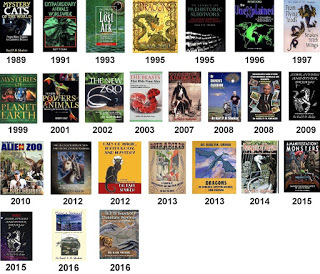 My first 25 books - click picture to enlarge (© Dr Karl Shuker)
My first 25 books - click picture to enlarge (© Dr Karl Shuker) Today is the fourth anniversary of my mother Mary Shuker's passing. I owe my lifelong love of reading, writing, and nature to Mom - her love for all wildlife nurtured my own from my earliest days, and her impeccable command of the English language tutored and guided my own throughout my life. Consequently, to commemorate and celebrate her kindly, positive, and truly immeasurable influence upon my entire existence and career, the present ShukerNature blog article is dedicated to my mother, and consists of a frequently-requested, currently-complete listing of all of the books that I have written, have acted as consultant for, have contributed to, or to which I have written a foreword. It will be updated whenever new books need to be added here.
Without you, Mom, none of my writings would have existed - God bless you, and thank you for the inestimable love, joy, happiness, and blessings that you gave to me and bestowed upon me by being in my life as my mother.
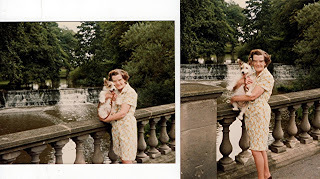 Mom and my Jack Russell terrier Patch during the mid-late 1970s (© Dr Karl Shuker)
Mom and my Jack Russell terrier Patch during the mid-late 1970s (© Dr Karl Shuker)Mystery Cats of the World: From Blue Tigers To Exmoor Beasts (Robert Hale Ltd: London, 1989)
Extraordinary Animals Worldwide (Robert Hale: London, 1991)
The Lost Ark: New and Rediscovered Animals of the 20th Century (HarperCollins: London, 1993)
Dragons: A Natural History (Aurum Press: London/Simon & Schuster: New York, 1995)
In Search of Prehistoric Survivors: Do Giant 'Extinct' Creatures Still Exist? (Blandford: London, 1995)
The Unexplained: An Illustrated Guide to the World's Natural and Paranormal Mysteries (Carlton Books: London/JG Press: North Dighton, 1996)
From Flying Toads To Snakes With Wings: From the Pages of FATE Magazine (Llewellyn Publications: St Paul, Minnesota,1997)
Mysteries of Planet Earth: An Encyclopedia of the Inexplicable (Carlton Books: London, 1999)
The Hidden Powers of Animals: Uncovering the Secrets of Nature (Reader's Digest: Pleasantville/Marshall Editions: London, 2001)
The New Zoo: New and Rediscovered Animals of the Twentieth Century [fully-updated, greatly-expanded, new edition of The Lost Ark] (House of Stratus Ltd: Thirsk, UK/House of Stratus Inc: Poughkeepsie, USA, 2002)
The Beasts That Hide From Man: Seeking the World's Last Undiscovered Animals (Paraview Press: New York, 2003)
Extraordinary Animals Revisited: From Singing Dogs To Serpent Kings (CFZ Press: Bideford, 2007)
Dr Shuker's Casebook: In Pursuit of Marvels and Mysteries (CFZ Press: Bideford, 2008)
Dinosaurs and Other Prehistoric Animals on Stamps: A Worldwide Catalogue (CFZ Press: Bideford, 2008)
Star Steeds and Other Dreams: The Collected Poems (CFZ Press: Bideford, 2009)
Karl Shuker's Alien Zoo: From the Pages of Fortean Times (CFZ Press: Bideford, 2010)
The Encyclopaedia of New and Rediscovered Animals: From the Lost Ark to the New Zoo - and Beyond (Coachwhip Publications: Landisville, 2012)
Cats of Magic, Mythology, and Mystery: A Feline Phantasmagoria (CFZ Press: Bideford, 2012)
Mirabilis: A Carnival of Cryptozoology and Unnatural History (Anomalist Books: San Antonio, 2013)
Dragons in Zoology, Cryptozoology, and Culture (Coachwhip Publications: Greenville, 2013)
The Menagerie of Marvels: A Third Compendium of Extraordinary Animals (CFZ Press: Bideford, 2014)
A Manifestation of Monsters: Examining the (Un)Usual Subjects (Anomalist Books: San Antonio, 2015)
More Star Steeds and Other Dreams: The Collected Poems - 2015 Expanded Edition (Fortean Words: Bideford, 2015)
Here's Nessie! A Monstrous Compendium From Loch Ness (CFZ Press: Bideford, 2016)
Still In Search Of Prehistoric Survivors - The Creatures That Time Forgot? (Coachwhip Publications: Darke County, 2016)
NB - Several of my books have also been published in various foreign-language editions, but for reasons of conciseness I have not itemised these separately here.
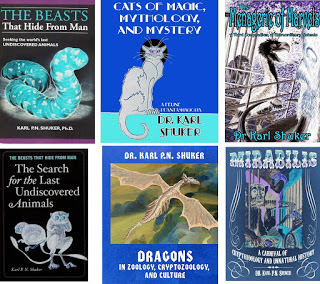 Something different - how various of my books' front covers would look if viewed as negatives (© Dr Karl Shuker)
Something different - how various of my books' front covers would look if viewed as negatives (© Dr Karl Shuker) Consultant and also ContributorMan and Beast (Reader's Digest: Pleasantville, New York, 1993)
Secrets of the Natural World (Reader's Digest: Pleasantville, New York, 1993)
Almanac of the Uncanny (Reader's Digest: Surry Hills, Australia, 1995)
The Guinness Book of Records/Guinness World Records 1998-present day (Guinness: London, 1997-present day)
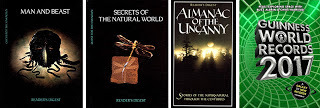
ConsultantMonsters (Lorenz Books: London, 2001)
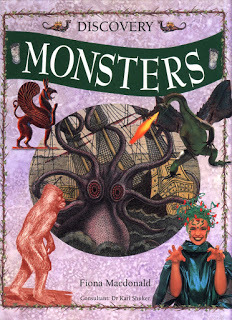
ContributorFortean Times Weird Year 1996 (Fortean Times/John Brown Publishing Ltd: London, 1996)
Mysteries of the Deep (Llewellyn: St Paul, 1998)
Guinness Amazing Future (Guinness: London, 1999)
The Earth (Channel 4 Books: London, 2000)
Chambers Dictionary of the Unexplained (Chambers: Edinburgh, 2007)
Chambers Myths and Mysteries (Chambers: Edinburgh, 2008)
The Fortean Times Paranormal Handbook (Dennis Publishing: London, 2009)
Death Worm: Metamorphosis of the Allghoi Khorkhoi [in Russian] (Salamandra P.V.V.: Moscow, 2014)
Folk Horror Revival: Field Studies (Wyrd Harvest Press/Lulu, 2015)
Tales of the Damned: An Anthology of Fortean Horror (Fortean Fiction: Bideford, 2016)
Plus numerous contributions to the Centre for Fortean Zoology's Animals and Men Yearbooks, Fortean Studies volumes, and various other annual publications.
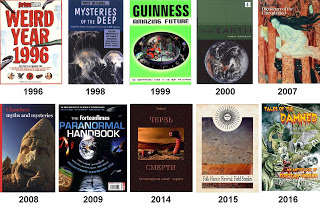
Contributor (CD ROM Format)Of Monsters and Miracles (Croydon Museum Services & Interactive Designs Ltd: Oxton, 1995)
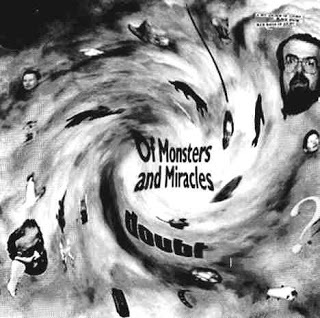
EditorJournal of Cryptozoology (CFZ Press: Bideford, 2012-present day)
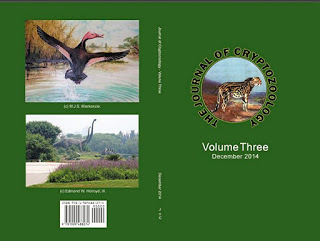
Contributor of Foreword to Other Authors' BooksDOWNES, Jonathan, The Smaller Mystery Carnivores of the Westcountry (CFZ Publications: Exwick, 1996)
SCREETON, Paul, Whisht Lads and Haad Yor Gobs: The Lambton Worm and Other Northumbrian Dragon Legends (Northeast Press Ltd: Pennywell, 1998)
BEER, Trevor, Trevor Beer's Nature Watch (Halsgrove: Tiverton, 1998)
BEER, Endymion, Down Ferny Lane (Edward Gaskell: Bideford, 2005)
JAMES, Corinna, and DOWNES, Jonathan (eds) CFZ Expedition Report 2006 Gambia (CFZ Press: Bideford, 2006)
ARNOLD, Neil, Monster! The A-Z of Zooform Phenomena (CFZ Press: Bideford, 2007)
DOWNES, Jonathan, and DOWNES, Corinna (eds), CFZ Expedition Report 2007 Guyana (CFZ Press: Bideford, 2007)
WOODLEY, Michael A., In the Wake of Bernard Heuvelmans: An Introduction to the History and Future of Sea Serpent Classification (CFZ Press: Bideford, 2008)
DOWNES, Jonathan (ed.), CFZ Expedition Report 2008 Russia (CFZ Press: Bideford, 2008)
MOLLOY, Nick, Predator Deathmatch (CFZ Press: Bideford, 2009)
FREEMAN, Richard, CFZ Expedition Report 2010 India (CFZ Press: Bideford, 2010)
PACIOREK, Andrew L., Strange Lands: A Field-Guide to the Celtic Otherworld (Andrew L. Paciorek: Howden-le-Wear, 2011)
GERHARD, Ken, Encounters With Flying Humanoids: Mothman, Manbirds, Gargoyles and Other Winged Beasts (Llewellyn Publications: St Paul, Minnesota, 2013)
LANG, Rebecca (ed.) The Tasmanian Tiger: Extinct or Extant? (Strange Nation Publishing: Sydney, 2014)
MUIRHEAD, Richard, Muirhead's Mysteries (CFZ Press: Bideford, 2016)
 A selection of the many foreign-language editions of my book Dragons: A Natural History currently published - click picture to enlarge (those shown here are as follows - From left to right, top row: English, Czech, Italian, Spanish, and Japanese; bottom row: Estonian, Hungarian, German, Dutch, and French. There are others, but I don't have copies of them so far - publishers are not always good at sending complimentary copies to the authors!) (© Dr Karl Shuker)
A selection of the many foreign-language editions of my book Dragons: A Natural History currently published - click picture to enlarge (those shown here are as follows - From left to right, top row: English, Czech, Italian, Spanish, and Japanese; bottom row: Estonian, Hungarian, German, Dutch, and French. There are others, but I don't have copies of them so far - publishers are not always good at sending complimentary copies to the authors!) (© Dr Karl Shuker)
Published on March 31, 2017 16:25
March 29, 2017
A COUPLE OF CRYPTO-PLATYPUSES FROM NORTH AMERICA
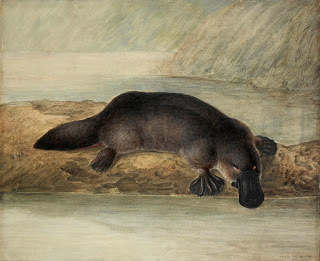 Platypus, painted by John Lewin, 1808 (public domain)
Platypus, painted by John Lewin, 1808 (public domain)The egg-laying, venom-spurred, electroreceptive, and thoroughly astonishing duck-billed platypus Ornithorhynchus anatinus has always been one of my favourite wild animals, and even today I can still readily recall how, as a small child during the early 1960s, my tiny plastic platypuses from my model zoo would, if left overlooked on a carpet or rug at home, unerringly find themselves sucked up into my unsuspecting mother's vacuum cleaner, resulting in an all-too-familiar, ominous clattering sound that always swiftly ensued before they were ejected in varying states of mangled morphology!
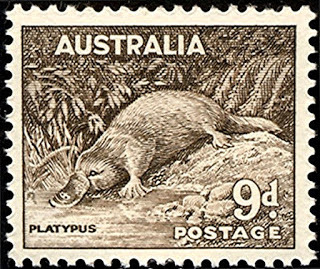 Platypus, depicted upon an Australian postage stamp issued in 1937 (public domain)
Platypus, depicted upon an Australian postage stamp issued in 1937 (public domain)Famed as an exclusively Australian oddity in the modern-day living state, no platypus species, from either the present or the palaeontological past, has ever been confirmed from North America – which is why the following couple of cryptozoological cases have long intrigued me.
 A platypus being shown to the public (© TwoWings/Wikipedia
CC BY-SA 3.0
)
A platypus being shown to the public (© TwoWings/Wikipedia
CC BY-SA 3.0
)Mystery beast investigators everywhere owe a great debt of thanks to longstanding cryptozoological and herpetological enthusiast Chad Arment, author of The Search For Hidden Animals (1995), for establishing a highly successful internet cryptozoological discussion group – cz@onelist.com (subsequently cz@yahoogroups.com) – that lasted for many years online. As its webmaster, Chad oversaw discussions concerning all manner of fascinating cryptids, including numerous examples not aired outside of cyberspace. Among the most remarkable, however, is one that Chad himself brought to the group's attention - the exceedingly curious case of the putative platypus from San Luis Valley, in Colorado.
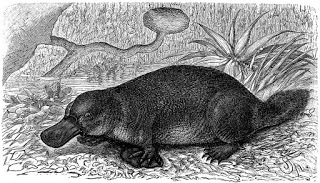 Platypus engraving, 1800s (public domain)
Platypus engraving, 1800s (public domain)In a short cz@onelist posting of 18 June 1999, Chad referred to Christopher O'Brien's book The Mysterious Valley (1996), in which O'Brien had briefly mentioned that strange animals have been seen for many years in San Luis Valley and that during the 1960s some individuals claimed to have found a supposed platypus in a high mountain lake within the Blanca Peaks area.
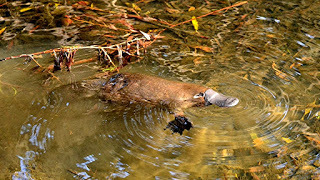 Platypus swimming (© Klaus/Wikipedia
CCBY-SA 2.0 licence
)
Platypus swimming (© Klaus/Wikipedia
CCBY-SA 2.0 licence
)Not surprisingly, Chad was curious to learn whether anyone else knew anything further. On 7 August 1999, Colorado-based cz@onelist crypto-contributor Bobbie Short posted an e-mail received by her that same day from a correspondent, Rob Alley, concerning this same subject. It read as follows:
Several years ago Mike F., a successful Ketchikan businessman, contractor and retired fisherman asked me following a chat about Sasquatches whether I had ever studied or read anything about platypuses in North America, specifically whether I knew of any prehistoric giant forms. When I got back to him on this and replied that there may have been a slightly larger earlier form known but not in N.A., but nothing really big, he looked puzzled. I asked him why and after a moment's hesitation he answered that as a young man forty or so years ago he had stood on shore near Mountain Point south of Ketchikan [in Alaska, USA] and spent a minute watching an animal in the water at very close range that simply resembled a giant platypus. He described the creature as dark with a bill and feet like a platypus only the overall size was six feet or possibly greater. He gave no mention of the tail if there was one. The sighting was in shallow water on a rocky shoreline and the creature was close to the surface. I could probably get a few more details such as season and so on. This man is an experienced commercial fisherman and stated categorically that it was not a known species of seal. Ocean temp here doesn't vary much from 50 degrees. All I have right now.
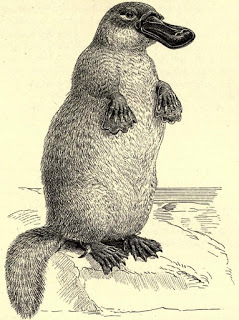 I've never seen or known of a platypus sitting upright – but if one did, or could, it may look like this wonderful 19th-Century natural history book engraving (public domain)
I've never seen or known of a platypus sitting upright – but if one did, or could, it may look like this wonderful 19th-Century natural history book engraving (public domain)The platypus is an egg-laying, monotreme mammal, and as noted by Rob Alley there are indeed larger species of monotreme on record, but these are all fossil forms, from Australasia (one such species, originally thought to have been a giant platypus, has since been reclassified as a zaglossid spiny anteater). In more recent years, fossil remains of monotremes have also been uncovered in the New World, but currently only in South America.
My painted concrete platypus (© Dr Karl Shuker)
These latter remains consist of a single upper and two lower teeth, which were found in Patagonia, Argentina, and date from the lower Palaeocene epoch (61 million years ago). In 1992, the species from which they originated was formally christened Monotrematum sudamericanum (but more recently some researchers have reclassified it within the existing Australian fossil genus Obdurodon). Its teeth are approximately twice as large as those of any other species of platypus, living or fossil, and it is currently the only platypus species known from outside Australia.
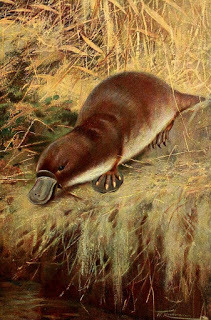 Platypus, from Wild Life of the World, A Descriptive Survey of the Geographical Distribution of Animals Volume III, by Richard Lydekker, 1916 (public domain)
Platypus, from Wild Life of the World, A Descriptive Survey of the Geographical Distribution of Animals Volume III, by Richard Lydekker, 1916 (public domain)As for living representatives, however, only one platypus species, Ornithorhynchus anatinus, is known, and that is of course exclusively Australian and freshwater. So if it was definitely not a seal, just what did Michael F. see near Mountain Point? An otter is the most likely non-cryptozoological possibility. Yet if his sighting was as good as it appears to have been, such an identity can hardly reconcile his description of a platypus-like bill and feet.
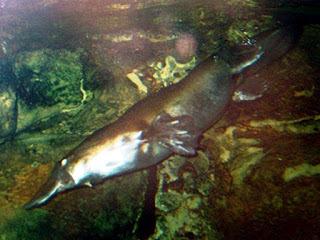 Platypus diving underwater (© Ester Inbar/Wikipedia free use)
Platypus diving underwater (© Ester Inbar/Wikipedia free use)As for the mountain lake, unnamed by Christopher O'Brien: in an e-mail to me of 26 September 1999, Bobbie stated that Blanca Peak is in Colorado's Sangre de Cristo mountains and the only lake up that high (approximately 14,300 ft) is Lake Como, so this is presumably the body of water in which the creature was sighted.
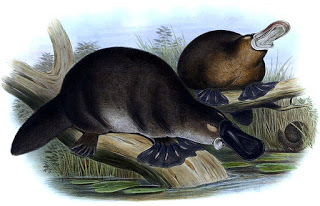 Platypuses, painted by John Gould, mid-1800s (public domain)
Platypuses, painted by John Gould, mid-1800s (public domain)Nevertheless, these two mystery platypus-lookalike beasts - one freshwater in Colorado, the other marine in Alaska - remain among the most tenuous, but also most tantalising, to have emerged from the depths of the Crypto-Web.
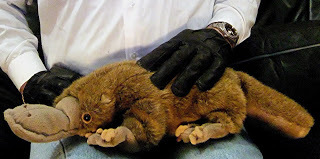 And finally – Ever imagined Ernst Stavro Blofeld as a cryptozoologist? Imagine no longer: "Good evening, Dr Shuker, I've been expecting you..." (© Dr Karl Shuker)
And finally – Ever imagined Ernst Stavro Blofeld as a cryptozoologist? Imagine no longer: "Good evening, Dr Shuker, I've been expecting you..." (© Dr Karl Shuker)UPDATE: 30 March 2017
Today, Chad Arment kindly drew to my attention a third crypto-platypus version reported from North America, but this time from Canada. In John Warms's book Strange Creatures Seldom Seen (2015), John collated a number of reports received by him of a mysterious aquatic beast allegedly resembling the North American beaver Castor canadensis in overall appearance and size, but instantly differentiated from this familiar rodent species by sporting a distinctive duck-like beak, which has reputedly been seen in several Manitoban and Saskatchewan lakes. Moreover, it is known locally by various First Nation names that translate into English as duck beaver, beaver duck, or duck mole.
John also recorded claims that specimens of this cryptid have actually been killed, but as is all too often the norm in cryptozoology these potentially invaluable specimens were never preserved and submitted for formal scientific examination to determine their precise zoological identity. One person affirmed that he had once captured such a creature in a beaver lodge - so could it be that at least this Canadian crypto-platypus form is in fact a developmentally aberrant, teratological version of the normal beaver? It could explain why, if true, a specimen was discovered inside a beaver lodge.
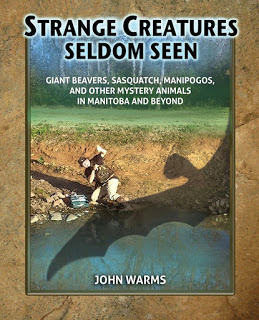
This ShukerNature blog article is excerpted and expanded from my book Extraordinary Animals Revisited .
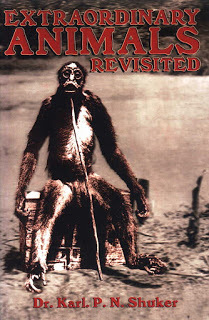
Published on March 29, 2017 10:14
March 19, 2017
THREE-HORNED RHINOCEROSES AND ALBRECHT DÜRER'S SHOULDER-HORNED SURPRISE
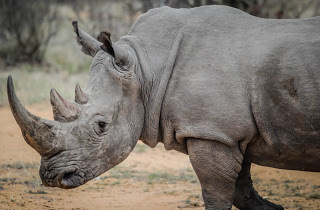 Digital creation of a three-horned white rhinoceros (digital manipulation © Dr Karl Shuker using a public domain photograph)
Digital creation of a three-horned white rhinoceros (digital manipulation © Dr Karl Shuker using a public domain photograph)There was the forest three-horned dark rhino that would be in small herds that would occasionally run into the snares of man. These forest rhinos were deemed by many as a prized possession.
Douglas S. Taylor – Sword of Souls: Chronicles of Caledon
The three-horned rhinoceroses referred to in the above quotation are fictitious, but factual records do indeed exist of rhino specimens possessing extra (supernumerary) horns. Of the five species of rhinoceros alive today, two of them (the great Indian Rhinoceros unicornisand the Javan R. sondaicus) each typically sports one horn, whereas the other three (the Sumatran Dicerorhinus sumatrensis, African white Ceratotherium simum, and African black Diceros bicornis) each typically sports two. Very rarely, however, exceptions to this standard rule arise, and as reported widely in the media during late December 2015 one such exception has lately been encountered and photographed in Namibia's Etosha National Park by 73-year-old Jim Gibson.
Eschewing its species' normal two-horn condition (and its taxonomic name too), the adult black rhinoceros Diceros bicornis(translating as 'two-horned two-horned') in question also bears a slender but distinctive, forward-curving third horn, sprouting forth from the centre of its brow (click here to see photos of this singular beast, and here to view a short video clip of it). Its extra horn would not cause this rhino any discomfort; and if resulting from a non-genetic developmental abnormality occurring when the rhino was a foetus, it would not be inherited by any of its offspring. If caused by a mutant gene, however, it could be inherited - this latter situation probably explaining why triple-horned black rhinoceroses were once quite common around Zambia’s Lake Young.
On 10 February 1906, big game hunter Abel Chapman shot a three-horned black rhinoceros at Elmenteita in British East Africa (now Kenya), and a photograph of Chapman posing alongside its head subsequently appeared in his book Retrospect: 1851-1928 (1928). That same book also included a drawing of this animal. And a similar specimen was exhibited alive at Lisbon Zoo, Portugal, as documented in two International Zoo Yearbook reports of 1978.
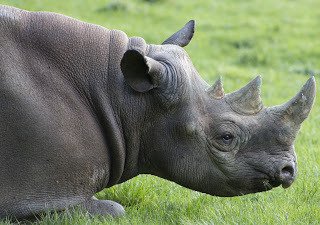 Digital creation of a three-horned black rhinoceros (digital manipulation © Dr Karl Shuker using a public domain photograph)
Digital creation of a three-horned black rhinoceros (digital manipulation © Dr Karl Shuker using a public domain photograph)Three-horned examples of unspecified two-horned rhinoceros species in southern Africa were alluded to by Swedish explorer-naturalist Charles J. Andersson in his book Lake Ngami (1861), which documented his four years spent exploring southwestern Africa, including time spent during 1854 at this nowadays very famous but then newly-discovered lake in Botswana:
I have met persons who told me that they have killed rhinoceroses with three horns; but in all such cases (and they have been but few), the third, or posterior horn is so small as to be scarcely perceptible.
Even Linnaeus mentioned three-horned rhinoceroses - to his description of the black rhinoceros in Gmelin’s edition (1788) of Systema Naturae was added: “Rarior est Rhinoceros tricornis, tertia cum cornu ex alterato priorem excrescente”. In the past, moreover, Sumatran native hunters asserted that three-horned specimens of the Sumatran rhinoceros were occasionally met with too.
In most cases, the extra horn is usually nothing more than a small, rounded knob - a rudimentary third horn positioned behind the two normal ones. Similarly, towards the end of the 19th Century, London Zoo exhibited a female great Indian rhinoceros that bore a rudimentary second horn upon her forehead. Alternatively, a pseudo-third horn can develop via the splitting into two of one of the normal, pre-existing horns, as seen in the following photograph of one such zoo specimen:
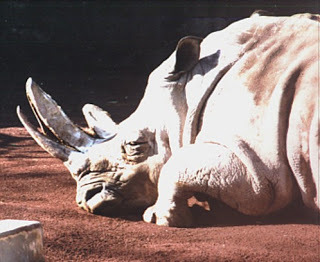 Captive rhinoceros with pseudo-third horn (© Owen Burnham)
Captive rhinoceros with pseudo-third horn (© Owen Burnham)Occasionally, even more extreme cases are recorded. One such individual was the abnormal female black rhinoceros shot during August 1904 in a dense covert west of Kenya’s Jambeni Mountains, at an elevation of 4150 ft above sea-level, and reported by Colonel W.H. Broun in the Proceedings of the Zoological Society of London on 14 November 1905. In addition to the two normal horns, this rhino had a third, rudimentary horn between its ears, plus a fourth, equally diminutive example located about 4 in further back.
During his extensive black rhinoceros researches, renowned German zoologist Dr Bernard Grzimek encountered reports of a five-horned specimen, and even of rhinos with horns growing out of their bodies. He also suggested that the famous woodcut of a great Indian rhinoceros bearing an incongruously-sited horn on its shoulder produced by Albrecht Dürer in 1515 (and later copied by Conrad Gesner in his Historiae Animalium, Liber I, 1551) may have been truly based upon an abnormally horned specimen.
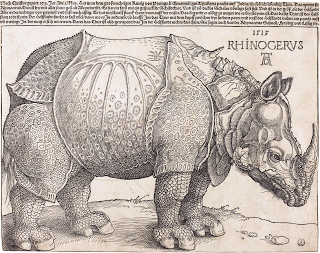 Albrecht Dürer’s famous shoulder-horned rhinoceros woodcut (public domain)
Albrecht Dürer’s famous shoulder-horned rhinoceros woodcut (public domain)At one time, this idea was discounted in favour of the theory that the horn was either an error on the part of Dürer, or, if genuine, merely an excrescence developed by the rhinoceros in question during its long confinement in the ship bringing it from India to Portugal’s King Manuel the Great, at Lisbon (the king then offering it up as a gift to Pope Leo X). Moreover, as discussed in 1961 via an entire paper on the subject written by Dr K.C.A. Schulz and published in African Wild Life, rough sores of a horny nature have been observed for some time among black rhinos too.
However, Grzimek’s view was reinforced in spring 1968, when Prof. Heini Hediger photographed a white rhinoceros living in San Francisco Zoo that bore a bona fide, unequivocal shoulder horn, measuring some 4 in high. Prof. Hediger subsequently documented this distinctive creature via an illustrated Zoologische Garten article published in 1970.
At present, the precise reasons for the development of extra horns by rhinoceroses remain relatively unclear. In some cases, a genetic origin is indicated, especially when they involve several multi-horned specimens inhabiting one specific locality, as with the Lake Young individuals. Injury-induced development (echoing the ‘excrescence theory’ for Dürer’s specimen) may also occur - as documented from various antelopes and deer possessing supernumerary (and often oddly located) horns, sometimes emerging from the forehead, face, or even sites on the body.
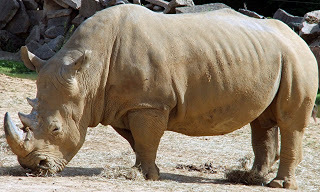 Digital creation of a three-horned southern white rhinoceros (photograph and digital manipulation © Dr Karl Shuker)
Digital creation of a three-horned southern white rhinoceros (photograph and digital manipulation © Dr Karl Shuker)NB – As noted in their respective credits above, all of the photographs of three-horned rhinoceroses included here have been created by me via digital manipulation of existing photographs of normal two-horned specimens, because although, as this present article of mine unequivocally demonstrates, rhinos with supernumerary horns are a reality, I am not aware of any existing photos of such specimens other than those of the above-documented Namibian individual and the photo in Abel Chapman's book depicting him alongside his three-horned rhino head (unfortunately, however, I have so far been unable to obtain sight of this latter picture).
Consequently, if anyone knows of any photographs depicting supernumerary-horned rhinos, or drawings based upon documented specimens of such creatures, I would greatly welcome details.
This ShukerNature blog article is excerpted and greatly expanded from my book Extraordinary Animals Revisited .
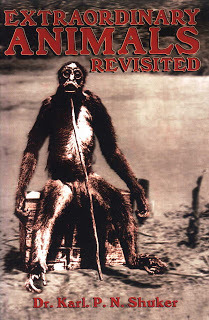
Published on March 19, 2017 06:25
March 7, 2017
POSTHUMOUS SIGHTINGS OF PASSENGER PIGEONS?
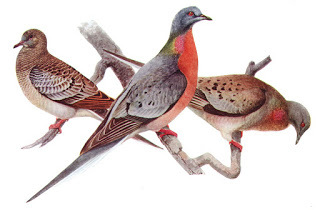 Passenger pigeons (juvenile, left; male, centre; female, right), from Birds of New York by Louis Agassiz Fuertes, 1910 – did this species survive beyond 1914? (public domain)
Passenger pigeons (juvenile, left; male, centre; female, right), from Birds of New York by Louis Agassiz Fuertes, 1910 – did this species survive beyond 1914? (public domain)The most numerous species of wild bird ever known was the phenomenally plentiful passenger pigeon Ectopistes migratorius, a dainty, slender-bodied, long-tailed bird with blue-grey head, neck, back, and wings, and cinnamon-pink underparts. It has been estimated that during the 19thCentury’s early years, its total population contained between five and ten thousand million birds. Or to put it another way, this single species may have accounted for as much as 45 per cent of the entire bird population of America! One of the most evocative descriptions of its immense numbers during its heyday appeared in The Mirror of Literature, Amusement, and Instruction for 16 November 1822:
The accounts of the enormous flocks in which the passenger, or wild pigeons, fly about in North America, seem to an European like the tales of Baron Munchausen; but the travellers are ‘all in a story.’ In Upper Canada, says Mr. Howison, in his entertaining ‘Sketches,’ you may kill 20 or 30 at one shot, out of the masses which darken the air. And in the United States, according to Wilson, the ornithologist, they sometimes desolate and lay waste a tract of country 40 or 50 miles long, and 5 or 6 broad, by making it their breeding-place. While in the state of Ohio, Mr. Wilson saw a flock of these birds which extended, he judged, more than a mile in breadth, and continued to pass over his head at the rate of one mile in a minute, during four hours — thus making its whole length about 240 miles. According to his moderate estimate, this flock contained two thousand two hundred and thirty millions, two hundred and seventy-two pigeons.
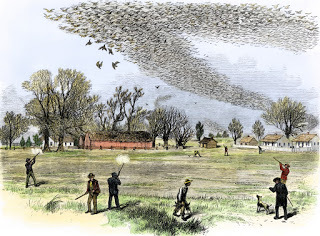 A flock of passenger pigeons being hunted in Louisiana, The Illustrated Shooting and Dramatic News, 1875 (public domain)
A flock of passenger pigeons being hunted in Louisiana, The Illustrated Shooting and Dramatic News, 1875 (public domain)It seems inconceivable that less than a century after the above report had been published the passenger pigeon had been completely exterminated, but this is precisely what happened.
As a result of an unutterably ruthless, relentless programme of persecution (on a scale unparalleled even in man’s nefarious history of wildlife destruction), perpetrated by trigger-happy gun-toters attracted by the awesome spectacle of the birds’ mass migrations, by 1 September 1914 only one solitary specimen remained alive. This was a 29-year-old hen bird named ‘Martha Washington’, exhibited at Cincinnati Zoo. And shortly after noonon that fateful September day, this last humble survivor of an ostensibly indomitable, indestructible species died. The unthinkable had happened - the passenger pigeon, whose vast migrating flocks had virtually eclipsed the sun in the time of the great American painter John James Audubon, was no more.
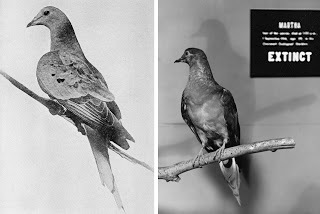 Martha Washington, the last known passenger pigeon, pictured alive on left, and as a taxiderm specimen at Washington DC's Smithsonian Institution on right (public domain)
Martha Washington, the last known passenger pigeon, pictured alive on left, and as a taxiderm specimen at Washington DC's Smithsonian Institution on right (public domain)Officially, that is. For at least another decade, alleged sightings of passenger pigeons were frequently reported, but scientists tended to dismiss these as mistaken observations of the smaller but closely related mourning dove Zenaida macroura, still a common species. In September 1929, however, a remarkable report emerged that could not be discarded so readily. This was the month in which Michigan University bacteriologist Prof. Philip Hadley, in the company of a Mr Foard, an old friend familiar with the land, had been hunting in a virtually uninhabited wilderness nestling within Michigan’s northern peninsula.
They had been hunting there for some time when Foard drew Hadley’s attention to a bird perched close by, and declared that it was a passenger pigeon - which he had observed in enormous numbers when younger. Needless to say, Hadley turned at once to spy this exceedingly unexpected specimen, but just as he caught sight of it the bird took flight. Nevertheless, it did seem to him to be pigeon-like in form, with a pointed tail, and he clearly believed the incident to be of significance, because he sent details to the eminent US journal Science, which in turn judged it to be important enough to warrant publication in its issue of 14 February 1930.
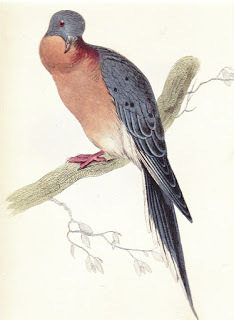 Passenger pigeon, from Pigeons, Sir William Jardine, 1835 (public domain)
Passenger pigeon, from Pigeons, Sir William Jardine, 1835 (public domain)Within his letter, Hadley also referred to a couple of other recent sightings, documented a month earlier by Kendrick Kimball in the Detroit News (5 January). One of these sightings had been made on 10 June 1929, by Robert H. Wright of Munissing, Michigan. Wright was convinced that the pair of birds that he saw at close range on Highway M-28, about 16 miles from Munissing, were passenger pigeons. In the other sighting, made between Indianapolis and Kokomo while driving from Florida, Dr Samuel R. Landes spotted a flock of approximately 15 birds that he readily identified as passenger pigeons. Both Wright and Landes were familiar with this species’ appearance — like so many others, they had shot hundreds of them during the late 1870s.
Nonetheless, the last confirmed wild specimen was shot in 1899, at Babcock, Wisconsin, so is it really possible that the birds reported three decades later by the eyewitnesses above were truly passenger pigeons? It seems rather unlikely, at least at first, because after the last major flocks had been slaughtered (in 1878), stragglers did not survive long, and matings became ever fewer. It seemed as if the species could only persist and reproduce when present in huge flocks. At the same time, of course, the familiarity of the eyewitnesses with the species makes their testimony all that more difficult to discount.
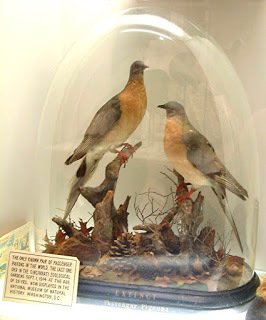 A pair of taxiderm passenger pigeons at San Antonio, Texas (© Jonathan Downes/CFZ)
A pair of taxiderm passenger pigeons at San Antonio, Texas (© Jonathan Downes/CFZ)Perhaps certain fairly secluded localities did house a last few specimens, which existed undetected beyond the date of Martha’s death, and possibly even mated every now and then, and which were encountered only when their flights traversed areas frequented by humans, or when humans occasionally passed by their hideaways. Yet without the immense congregations necessary to provide the stimulus for normal, full-scale reproduction, they could surely do no more than extend their species’ survival by a few years. Long before the last individual had died, whether in 1914 or in the 1930s, the passenger pigeon’s descent into extinction had already begun, irrevocably and inevitably, with the disappearance of its vast flocks. After that, it could only be a matter of time.
Surely, then, the ‘passenger pigeon’ spied in March 1965 at Homer, Michigan, by Irene Llewellyn (Fate, September 1965) and another spied the same year by Stella Fenell at New Jersey’s Park Ridge (Fate, January 1966), not to mention an intriguing series of recently-claimed passenger pigeon sightings chronicled online in 2014, 2015, and 2016 by the website HoriconBirds.com, were only mourning doves ... weren’t they?
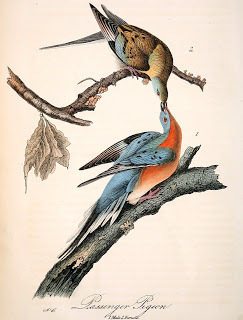 John James Audubon's famous painting of a pair of passenger pigeons, from his spectacular tome The Birds of America, 1827-1838 (public domain)
John James Audubon's famous painting of a pair of passenger pigeons, from his spectacular tome The Birds of America, 1827-1838 (public domain)An Antipodean equivalent of sorts is the flock pigeon Phaps (=Histriophaps)histrionica, also known as the flock bronzewing. In the 1800s, huge flocks, containing millions of birds, lived on the grass plains of New South Wales and Queensland. Today, though, it is a relatively rare species (it was once thought to be extinct), categorised as Threatened by the IUCN.
This time, however, the cause is not man himself but his animals. The flock pigeon is a seed-eater, but generations of grazing cattle and sheep have prevented the plains’ grass from seeding adequately.
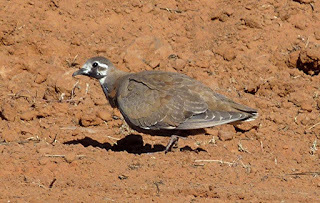 A flock pigeon (© Christopher Walker/Wikipedia –
CC BY-SA 3.0 licence
)
A flock pigeon (© Christopher Walker/Wikipedia –
CC BY-SA 3.0 licence
) Of course, courtesy of the extraordinary technological advances taking place daily in the modern-day world that we all inhabit, perhaps we should never say never in relation to the prospect of one day seeing bona fide passenger pigeons alive and well again. On 8 February 2012, a meeting was convened at Harvard Medical School in Boston, Massachusetts, by a group of interested researchers from the non-profit genetic research organisation Revive & Restore, to explore the technical plausibility of resurrecting this iconic species via genomic engineering, as well as to examine the potential cultural, social, political, and ecological ramifications of restoring it to life and perhaps even reintroducing it into the wild. After presentations by a range of participants and discussions concerning their contributions, the group concluded that the genetic technique proposed should be tested to see how effective it may be, and how it could be improved, with this goal in mind.
So who knows? Maybe one day the passenger pigeon will indeed return, if no longer to darken the skies with vast flocks as in former times but at least to live again in the land where it rightfully belongs and where it would certainly have remained had its existence not been wilfully extinguished by our own species.
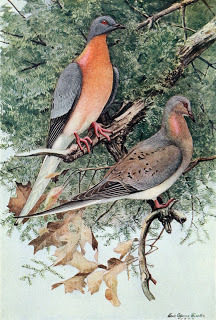 Passenger pigeons, frontispiece to The Passenger Pigeon, 1907 (public domain)
Passenger pigeons, frontispiece to The Passenger Pigeon, 1907 (public domain)For my tribute in verse to the passenger pigeon, please click here ; and for its philatelic prominence, please click here .
This ShukerNature blog article is excerpted and expanded from my book Extraordinary Animals Revisited .
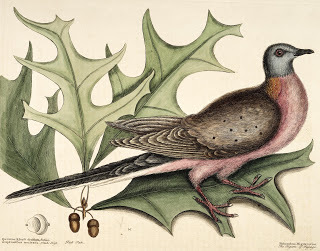 Passenger pigeon, Plate 23 in Vol 1 of The Natural History of Carolina, Florida and Bahamas by Mark Catesby, George Edwards, 1754 (public domain)
Passenger pigeon, Plate 23 in Vol 1 of The Natural History of Carolina, Florida and Bahamas by Mark Catesby, George Edwards, 1754 (public domain)
Published on March 07, 2017 19:56
March 3, 2017
TODAY I RECEIVED MY GOLDEN YETI AWARD – AND NOT A WRONG ENVELOPE IN SIGHT!
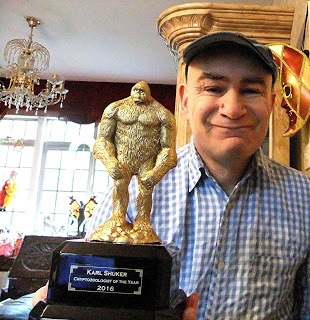 With my Golden Yeti award for Cryptozoologist of the Year 2016 (© Dr Karl Shuker)
With my Golden Yeti award for Cryptozoologist of the Year 2016 (© Dr Karl Shuker)I'm very happy to announce that my Golden Yeti – verily the Oscar and BAFTA of cryptozoology – awarded to me as Cryptozoologist of the Year 2016 by Loren Coleman and the International Cryptozoology Museum in December 2016, has arrived today safe and sound, presented to me by a very nice lady from ParcelForce, and with neither a wrong envelope nor even a Stephen Fry anywhere in sight! Joy indeed!
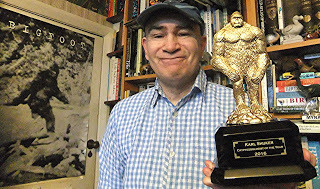
And here it, photographed just before it took up residence in pride of place on my mantelpiece alongside a silver unicorn and a nautilus shell, and next to my mother's armchair, so that if somehow, as I so fervently hope and as very many friends and colleagues have assured me during the past four years, she is still close by, watching over me, she will see it and know that her lad whom she loved so much is still doing his best to continue to make her proud, in grateful thanks for all the love, encouragement, and guidance that she always gave me throughout our 53 wonderful shared years.
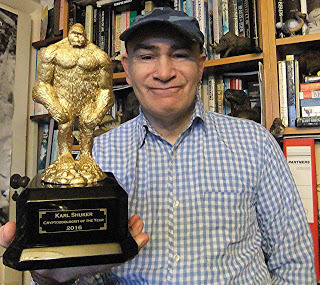
My sincere thanks again to Loren and to the ICM for honouring me and recognising my cryptozoological contributions with this fine award, and above all to Mom, without whom none of this would ever have been possible.
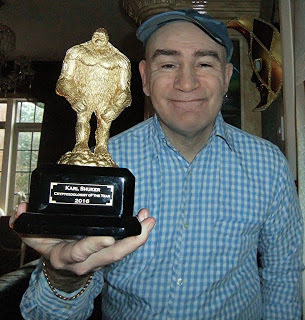
"Alongside a silver unicorn and a nautilus shell..."
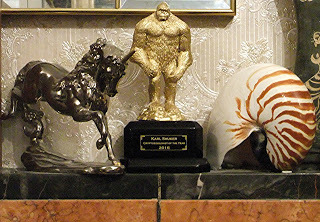
All photographs © Dr Karl Shuker
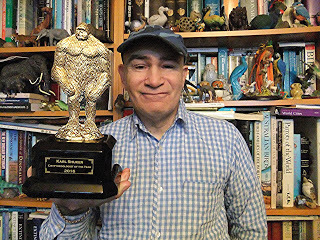
Published on March 03, 2017 07:55
February 26, 2017
THE GIANT GRASSHOPPER OF WISCONSIN - FOCUSING UPON A PHONEY PHOTOGRAPH
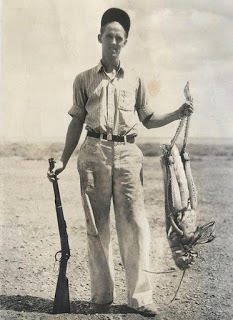 The iconic photograph of A.L. Butts holding up a supposed giant grasshopper that he had allegedly shot dead in his apple orchard during 1937 (public domain)
The iconic photograph of A.L. Butts holding up a supposed giant grasshopper that he had allegedly shot dead in his apple orchard during 1937 (public domain)During the late 1970s and early 1980s, I purchased a trio of fascinating books that totally captivated me, reading them from cover to cover and then re-reading them numerous times thereafter. Indeed, even today I still return to them periodically and dip inside their fact-filled pages. Presented by The People's Almanac, these international bestsellers were: The Book of Lists (1977), The Book of Lists 2 (1980), and The Book of Lists 3 (1983). They were written by David Wallechinsky, Irving Wallace, and Amy Wallace, and, as their titles suggest, they were packed throughout with annotated lists on every conceivable subject, and included many specialist ones that were compiled by a lengthy series of credited contributors with extensive knowledge on those particular s objects.
One of my favourite lists appeared in the third book of this series. Entitled '8 Worst Monster Hoaxes', the list had been compiled by none other than cryptozoology's very own Loren Coleman, and included concise accounts of such famous crypto-frauds as Phineas Barnum's Feejee mermaid, the giant model used in the notorious Silver Lake monster hoax, the supposed living Jersey devil put on show that proved to be a kangaroo painted with green stripes and with fake wings attached (click here to read my ShukerNature account of this faux monster), the controversial photo of de Loys's supposed South American ape, and – a case that I'd not encountered until reading this book – the giant grasshoppers that allegedly invaded the apple orchard of farmer A.L. Butts from Wisconsin. Here, quoting from his list, is what Loren wrote concerning this extraordinary episode:
GIANT GRASSHOPPERS OF BUTTS ORCHARDOn Sept. 9, 1937, the following headline appeared on the front page of the Tomah (Wis.) Monitor-Herald: "Giant Grasshoppers Invade Butts Orchard East of City." The accompanying story gave details of the invasion. Apparently, after eating some special plant food that farmer A. L. Butts had sowed on his apple orchard, the grasshoppers grew to an astounding 3 ft. in length—large enough to snap off tree limbs as they leaped about the orchard. Along with the article, there were photographs of the mutant insects being hunted with shotguns. Because the story was continued on page four, many readers never got to the final paragraph, which suggested that it was all a put-on: "If there are those who doubt our story it will not be a new experience, inasmuch as most newspaper writers are thought to be the darndest liars in the world." The elaborate hoax was concocted by Mr. Butts and the Monitor-Herald publisher, B. J. Fuller.
 My greatly-treasured copy of The Book of Lists 3 (© David Wallechinsky, Irving Wallace, and Amy Wallace / Corgi Books - reproduced here on a strictly non-commercial Fair Use basis only)
My greatly-treasured copy of The Book of Lists 3 (© David Wallechinsky, Irving Wallace, and Amy Wallace / Corgi Books - reproduced here on a strictly non-commercial Fair Use basis only)Accompanying Loren's account was the eyecatching photograph that opens this present ShukerNature blog article of mine, except that in Loren's account the photo was reproduced by the book's publisher in mirror-image format, the only instance that I'm aware of in which it has appeared in this orientation. It was one of the pictures that had been included in the above-noted Tomah Monitor-Herald newspaper's hoax report.
Not surprisingly, with the coming of the internet such a striking image as this one was not going to go unnoticed and uncommented-upon online, and indeed, it currently appears on countless websites. Yet although on the vast majority of these sites it is readily denounced as a hoax, there is rarely if ever any provision of details supporting such a claim, and on some sites there is even earnest discussion as to whether it actually is a hoax or whether the giant grasshopper portrayed in it is real!
In both situations, therefore, it would appear that all such sites are blissfully unaware of Loren's above-quoted account, and also of the more recent version by Leland Gregory – a concise coverage of this phoney incident appearing in Gregory's wonderfully-entitled book Stupid History: Tales of Stupidity, Strangeness, and Mythconceptions Throughout the Ages (2007). It includes the following specific details concerning the photographs contained in the hoax newspaper report: "Accompanying the article were photographs of shotgun-toting hunters tracking down the mutant insects as well as a picture of Farmer Butts holding up a dead grasshopper like a prize fish" – the latter being an excellent description of the famous image opening my own article here. But that is not all.
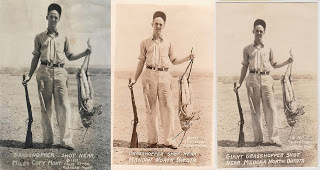 Picture postcards from 1937 featuring this iconic giant grasshopper image but giving different claimed locations for it; note also that in the middle postcard the grasshopper seems to be held at a slightly different angle, and with both antennae hanging down, indicating that this is a second, hitherto-unrecognised photo - see below for more details (public domain)
Picture postcards from 1937 featuring this iconic giant grasshopper image but giving different claimed locations for it; note also that in the middle postcard the grasshopper seems to be held at a slightly different angle, and with both antennae hanging down, indicating that this is a second, hitherto-unrecognised photo - see below for more details (public domain)In many online sites containing this photograph, it takes the form of a vintage-looking picture postcard, inasmuch as beneath the main portion of the image (containing Butts holding the grasshopper) but superimposed upon the lowermost portion of the image itself (a section of ground present below Butts's feet and rifle end that was not present in the version of this picture accompanying Loren's account, which was therefore cropped as well as mirror-image-reversed) is white handwriting in the style that was frequently seen in such picture postcards dating back to the first half of the 20th Century. This handwriting provides the location where the photograph was supposedly taken, plus the photo's copyright owner and year.
In most examples that I have seen, the information given is: 'GRASSHOPPER SHOT NEAR MILES CITY MONT. © 1937 COLES STUDIO GLASGOW MONT'. However, I have also seen versions in which the location is variously given as 'NEAR MANDAN NORTH DAKOTA', and 'NEAR MEDORA NORTH DAKOTA' (and in this latter version, the adjective 'GIANT' is applied to the grasshopper). The year and copyright details, conversely, are the same as those given in the Miles City Montana version.
Of particular interest, moreover, is that in one such version (pictured above), labelled as 'NEAR MANDAN NORTH DAKOTA', the angle at which the grasshopper is being held by Butts is slightly different from in all other versions seen by me, and with both of its antennae (not just one) hanging downwards, as well as more of its feet emerging from out of Butts's fist. In other words, this is apparently a second, hitherto-unrecognised photograph of Butts and the giant grasshopper, yet clearly produced during the same session as the famous one, because Butts's pose is identical in both, whereas the grasshopper's is very similar - but not identical - in both.
There are also various additional versions online that may be of more recent date, as the locations given are simply added in typescript within a separate block beneath the entire image, rather than as handwriting superimposed upon the lowermost portion of the image. One such example gives the supposed location of where the 'giant grasshopper' was shot as 'Near C.P.R. Station Moose Jaw, Sask.', with 'Sask.' being an abbreviation for the state of Saskatchewan in Canada. (There are also all manner of modern-day parodies, spoofs, and pastiches of this now-classic image online, featuring characters from famous television shows, computer/video games, and much more besides.)
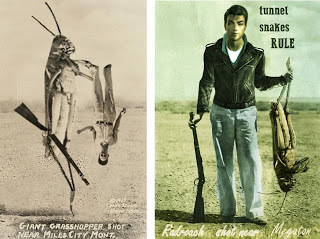 Two spoofs of the Butts giant grasshopper photograph: the left-hand-one provides a humorous twist to its content; the right-hand-one features Butch DeLoria, leader of the Tunnel Snakes gang in Fallout 3, an action role-playing open world video game that includes giant cockroach-like insects called radroaches (© owner unknown to me / © Fallout Wiki)
Two spoofs of the Butts giant grasshopper photograph: the left-hand-one provides a humorous twist to its content; the right-hand-one features Butch DeLoria, leader of the Tunnel Snakes gang in Fallout 3, an action role-playing open world video game that includes giant cockroach-like insects called radroaches (© owner unknown to me / © Fallout Wiki)Bearing in mind that the hoax was set in Wisconsin, USA, all of the above-noted claimed locations for the grasshopper shooting given on the various picture postcards are themselves fake. But once again, that is not all. What is particularly odd, and therefore very intriguing, is that I have yet to find a single picture postcard of this image online that actually gives anywhere in Wisconsin as the claimed location!
Moreover, the very fact that there are in existence picture postcards depicting this image that date back to 1937, the exact same year in which the hoax report was published by the Tomah Monitor-Heraldnewspaper, makes me wonder which came first – the picture postcards or the newspaper hoax? If the hoax came first, then the postcards were made as a spin-off using the image from the report and with the writing giving supposed location and copyright details being subsequently added. But if the postcards came first, complete with the writing present, then the writing would need to be removed from them before the image could be included in the report. The easiest way to do this would be simply to crop the photo to just below Butts's feet (exactly as was done in The Book of Lists 3), thereby deleting the lowermost portion of the image containing the writing. But if the latter is true, does this mean that the hoax newspaper report was actually inspired by (and thus made direct use of) a pre-existing picture postcard that occurred with different claimed locations written upon it, but set its fictitious incident in a location (Wisconsin) separate from any of those claimed on the postcard versions?
An answer to this key question may well be forthcoming if we knew what format the giant grasshopper photograph takes in the newspaper report? Is the full image present, including the lowermost portion of ground beneath Butts's feet and rifle end but with no writing superimposed, thus confirming that the newspaper report came first? Or is the image cropped to just below Butts's feet, thereby strongly suggesting (albeit not confirming) that there may have been writing on the deleted lowermost portion?
That is definitely the all-important question here, one that might shed major new light upon the origin of this iconic photograph. Yet, maddeningly, it is also one that I am presently unable to answer – for the simple yet highly frustrating reason that so far I have been unable to set eyes upon a copy of the two-page hoax report from the Tomah Monitor-Heraldnewspaper of 9 September 1937. I have managed to locate a version of this story that appeared in the Juneau County Chronicle (of Mauston, Wisconsin) on 16 September 1937, but this is a much shorter version, and only includes a single photograph (and which, unfortunately, is not the one under consideration here), one that is again an evident but much less professionally-produced hoax image.
 Section of the front page of the Juneau County Chronicle for 16 September 1937 containing the giant grasshopper story (public domain)
Section of the front page of the Juneau County Chronicle for 16 September 1937 containing the giant grasshopper story (public domain)That same photograph, incidentally, depicting Butts and someone else shooting a giant grasshopper in Butts's orchard, is also apparently the opening photo in the original Tomah Monitor-Herald report, and I have been kindly informed by Facebook friend and correspondent Bob Deis that the other person in the photo is none other than B.J. Fuller from the Tomah Monitor-Herald, who, as noted earlier, co-engineered the hoax with Butts.
Bob has given me a cutting from the Daily Tribune (Wisconsin Rapids) newspaper of 14 September 1937 that confirms this, Fuller openly admitting the hoax with Butts (variously spelt 'Butz' and 'Buts' here). Confusingly, this cutting initially names Fuller as merely a reporter for the Tomah Monitor-Herald, not as its editor (naming L.W. Kenny as editor instead), thereby seemingly contradicting Loren's afore-quoted account, but a few paragraphs later it then does name Fuller as editor! It also identifies the person who took that particular photograph of the two men shooting the giant grasshopper as one Reverend H.S. Schaller. I wonder if Schaller also took the famous photo of Butts holding up the giant grasshopper under consideration here? Thanks very much Bob for providing me with this informative cutting! And here it is:
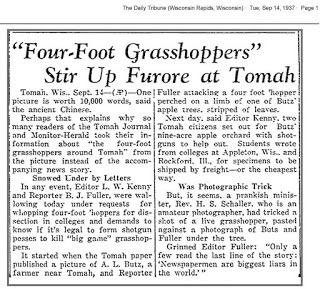
Cutting from the Daily Tribune(Wisconsin Rapids), 14 September 1937, confirming that the Wisconsin giant grasshopper hunt was indeed a hoax concocted by Butts and Fuller (public domain)
Needless to say, moreover, if anyone reading this ShukerNature article can provide me with a copy of the elusive Tomah Monitor-Herald report (or even any details concerning the appearance of the photograph in question here), I would very much appreciate it!
Well worth pointing out here is that picture postcards may well be linked to this hoax newspaper report in more ways than one, because it just so happens that in 1935, i.e. at least two years beforethis report was published, a picture postcard photographer/publisher named Frank D. Conard from Garden City, Kansas, had begun issuing what would become a very lengthy series of popular postcards depicting humorous illustrations featuring giant grasshoppers and spanning three decades.
Long before Photoshop was ever thought of, and eschewing even the popular optical illusion of forced perspective, Conard created his delightful pictures by simply but very effectively inserting enlarged images of grasshoppers into all manner of everyday scenes (a selection of which can be seen below). He also produced similar montage-based pictures featuring other enlarged images of animals, including jackrabbits and fishes. Picture postcards in this highly-collectible genre are known as exaggeration postcards.
 A selection of Frank D. Conard's giant grasshopper-themed exaggeration postcards – click to enlarge (public domain)
A selection of Frank D. Conard's giant grasshopper-themed exaggeration postcards – click to enlarge (public domain)Conard in turn had been inspired to produce his giant grasshopper-themed exaggeration postcards by a real-life grasshopper-featuring event that had taken place in Garden City, Kansas, during 1935. Namely, a major a plague of grasshoppers (albeit of normal size, happily!), which had attracted considerable media attention elsewhere across the USA, as other prairie states were also suffering from similar scourges at that time. In a December 2004 article concerning exaggeration picture postcards that was published on the Kansas Historical Society's website, Conard is quoted as having once said:
The idea [for producing his famous giant grasshopper-themed exaggeration postcards] came to me after a flight of grasshoppers swarmed into Garden City attracted by the lights, and it was impossible to fill an automobile gasoline tank at filling stations that night. I went home to sleep, but awoke at 3:00 a.m. and all I could think about was grasshoppers. By morning I had the idea of having fun with the grasshoppers, and took my pictures and superimposed the hoppers with humans. I didn't do it for adverse impressions of Kansas, but as an exaggerated joke.
Taking all of this into account, could it be that Coles Studio of Glasgow, Montana, the publisher of the picture postcards featuring Butts and the giant grasshopper and labelled with a variety of different claimed locations, was inspired by those of Conard, and/or by the real events that in turn had inspired Conard, to create some grasshopper-themed exaggeration postcards of its own? Indeed, can we even be absolutely certain that the person in this image actually is Butts? After all, if the postcards came first, before the hoax newspaper report, with one such postcard merely being the inspiration for the report and then simply included within it when it was finally published, who can say for certain who the person is in the image? It could be anyone. Butts might simply have lent his name to the hoax newspaper report, with the photo featuring whoever it was who had posed for it as a Coles Studio picture postcard long before the hoax newspaper story had ever been conceived.
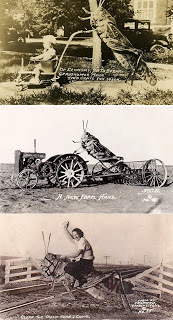 A second selection of Frank D. Conard's giant grasshopper-themed exaggeration postcards – click to enlarge (public domain)
A second selection of Frank D. Conard's giant grasshopper-themed exaggeration postcards – click to enlarge (public domain)I've spent a fair amount of time online seeking any details or publication lists appertaining to the output of Coles during the 1930s, in the hope of pinning down specifically when in 1937 the grasshopper postcards depicting Butts (or whoever it is) holding the giant grasshopper were first issued, but, sadly, all to no avail.
As for the giant grasshopper itself: one further intrigue awaits consideration. Does the picture postcard depicting it simply consist of an enlarged photo of a normal grasshopper that has been carefully inserted into a photo of Butts(?) in the normal montage-style manner of creating exaggeration picture postcards (but in at least two slightly different poses, as revealed earlier)? Or could the grasshopper have possibly been an actual full-sized giant grasshopper model?
The reason that I ask this is twofold. Firstly, on some websites I have seen claims, albeit unsubstantiated by any supporting evidence, alleging this to be the case. Secondly, although it seems an unlikely prospect there is in fact a notable fully-confirmed precedent – one that involves the following 'giant grasshopper' photograph, which again appears on numerous websites:
 Holding down a giant grasshopper – actually a model (public domain)
Holding down a giant grasshopper – actually a model (public domain)As with the Butts photo, there are all kinds of claims circulating online regarding it being a hoax image, alongside other claims questioning whether the grasshopper is actually a bona fide living giant grasshopper. In fact, it is neither – as revealed on 8 October 2012 by Maureen A. Taylor in her Photo Detective column within Family Tree Magazine (and viewable online here ). Following an investigation of this tantalising image, Maureen discovered that the giant grasshopper was an iron sculpture that had been created by Thomas Talcott Hersey of Mitchell, South Dakota, during the late 1930s, yet again as a result of being inspired by the real-life grasshopper plagues of that period, one of which had killed his own crops in his home state. Moreover, Hersey's giant grasshopper sculpture, which he had dubbed Galloping Gertie, attracted considerable interest and attention. Indeed, as Maureen noted:
When he displayed his invention at Corn Palace Week in Mitchell and charged a nickel to view it, he earned enough to support his family for a winter. Hersey ended up with a commission from a man who hired him to make a housefly, a flea, a black widow spider and a monarch butterfly to show at county fairs.
Hersey even produced a picture postcard of Galloping Gertie (the image included by me above), in which he is shown pretending to hold it down, assisted by his nephew Harry (Bart) Hersey and David John Hersey, and which also bears the caption 'Capturing "Whopper Hopper" near Mitchell, S.D. The largest grasshopper in existence 54 inches long weight 73 pounds'. And it is this picture, often reproduced sans caption, which is the one doing the rounds online. So, yes, models of giant grasshoppers are not beyond the realms of possibility at all.
As for real-life giant grasshoppers, conversely, that of course is a very different matter. For fundamental anatomical and physiological regions, especially ones relating to respiration, no species of insect living today could attain the stature of those included in any of the images presented above in this present article. Having said that, and albeit on a much more modest scale, there are some undeniably impressive species of grasshopper native to various parts of North America, but none more so, surely, than the eastern lubber grasshopper Romalea microptera (=guttata).
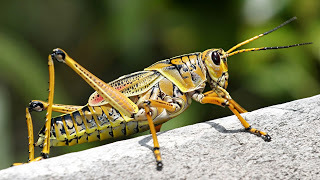 An eastern lubber grasshopper (public domain)
An eastern lubber grasshopper (public domain)Common throughout Florida, but up to 4 inches long, and brightly coloured in garish yellow, orange, and red with black stripes to warn would-be predators of its toxic nature, it came as something of a shock to me when I first encountered this monstrous entity while visiting the Everglades back in 1981. Aslow-moving species not given to energetic hopping and generally too heavy to fly via its undersized wings, there seemed to be lubbers crawling underfoot everywhere, emitting loud hisses and secreting foul-smelling foamy exudations, until I was more than happy to step onto one of the boats to take me away from these hexapodal horrors and on through what seemed by comparison to be the relative tranquillity of the alligator-infested swamps!
Meanwhile, my search here and online continues apace for the final piece of the long-incomplete jigsaw constituting the mystery of the Butts giant grasshopper phoney photograph – that evanescent newspaper report from the Tomah Monitor-Herald of 9 September 1937. Once – if ever – I have that to hand, I may finally be able to determine in best chicken and egg tradition which came first, the Coles Studio picture postcards of this memorable image or its appearance in the newspaper report.
So, once again, if there is anyone out there reading this ShukerNature article who can offer any information (including a specific first publication date for the picture postcards), or, best of all, an image of the two-page newspaper report, I would be very happy to hear from you!
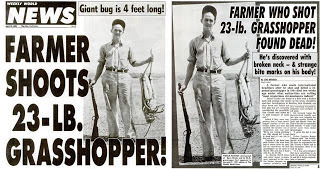 Two enthralling Weekly World Newsstories featuring the Butts giant grasshopper photograph (© Weekly World News – included here on a strictly non-commercial Fair Use basis only)
Two enthralling Weekly World Newsstories featuring the Butts giant grasshopper photograph (© Weekly World News – included here on a strictly non-commercial Fair Use basis only)Finally: how could any photograph featuring a man holding a 3-ft-long grasshopper fail to attract the attention of the wonderful Weekly World News? Sure enough, this inestimable publication has featured the Butts photo in not one but two WWN stories. In the first, published on 9 April 1991, it was used as the basis of a highly entertaining report concerning a New Zealand farmer named Barry Gissler who had shot a 23-lb giant grasshopper less than a month earlier, on 15 March. And in the second, published just over a year later on 16 June 1992, the unfortunate Mr Gissler had alas been found dead with a broken neck and strange bite marks on his body. Had New Zealand's mega-hoppers taken revenge upon the murderer of one of their burly six-legged brethren? Only the WWN can answer that question – and who knows, perhaps one day, in a third fascinating instalment of this gripping grasshopper yarn, it will do!
Incidentally, just in case you were wondering: The world's largest known true grasshopper (as opposed to the highly-specialised wetas of New Zealand) is a currently-unidentified species documented from the border of Malaysia and Thailand that measures 10 in long and is capable of leaping up to 15 ft. So perhaps giant grasshoppers are not such a figment of fantasy after all!
NB – As far as I am aware, all of the illustrations included here are in the public domain unless stated otherwise. In any case, however, they are all included here on a strictly non-commercial Fair Use basis only, exclusively for educational, review purposes.
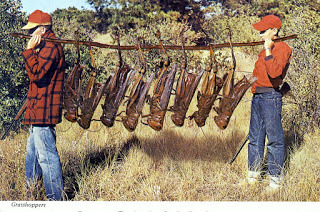 A vintage giant grasshopper-themed exaggeration postcard in colour (© currently unknown to me despite having made considerable searches for information – any available details will be gratefully received)
A vintage giant grasshopper-themed exaggeration postcard in colour (© currently unknown to me despite having made considerable searches for information – any available details will be gratefully received)UPDATE – 26 February 2017-02-26
Re-reading the Daily Tribune (Wisconsin Springs) article kindly supplied to me earlier today by Bob Deis, I am struck by the fact that it repeatedly refers to only "a picture", "one picture", etc, with the picture in question being the one of Butts and Fuller shooting a giant grasshopper in Butts's orchard – the same picture that is the only one in the Juneau County Chronicle report of this incident too. Conversely, no mention is made or even alluded to of there being any additional ones, including the famous one that is the subject of this current ShukerNature blog article of mine, even though the latter photo has always been directly associated with this hoax incident. Coupling this odd situation with the extensively-discussed fact here that the latter photo is known to have existed as a Coles Studio picture postcard in 1937 anyway, a very intriguing and quite dramatic thought has just entered my head.
Is it possible that this entire, ostensibly long-accepted association of phoney photo with hoax incident is fallacious, i.e. that the famous photo discussed here by me really was nothing more than a Coles Studio exaggeration picture postcard that simply happened to be in existence at the same time as the hoax incident was reported by the Tomah Monitor-Herald(just like several giant grasshopper-themed exaggeration picture postcards by Frank D. Conard also happened to be in existence at this same time), and that in fact it has nothing whatsoever to do with that incident, but has somehow been erroneously linked to (and ultimately directly incorporated into) the story of that hoax?
In other words, could it be that for many decades and right up into the present day, the Coles Studio exaggeration photograph has been wrongly assumed to be a photograph produced for the hoax incident and portraying Butts, when in reality it has nothing whatsoever to do with any of this at all, and therefore does not portray Butts? As can be seen from my article's discussion, the very fact that it had handwriting superimposed upon it in the same style as exaggeration photographs from that period in time, and dating it to 1937, had already alerted me to the possibility that it had already been released by Coles Studio as an exaggeration postcard before the hoax newspaper report had ever been published.
Clearly, therefore, more than ever now I would like to see the original Tomah Monitor-Herald report of 9 September 1937 – because if this famous phoney photograph, so long directly associated with this hoax incident, is not contained in that report, it means that its entire public history for decades has been a lie, with everyone who has ever written about it claiming that it shows Butts with one of the supposed giant grasshoppers from his orchard having been mistaken. And that is something that needs to be determined one way or another, and documented accordingly, as soon as possible.
Incidentally, be sure not to miss out on Bob Deis's awesome Cryptozoology Anthology: Strange and Mysterious Creatures in Men's Adventure Magazines – check it out here !
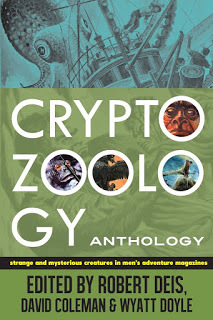
Published on February 26, 2017 02:03
February 24, 2017
ARE FRUIT BATS FLYING PRIMATES? ANOTHER RETROSPECTIVE FROM OUT OF THE ARCHIVES
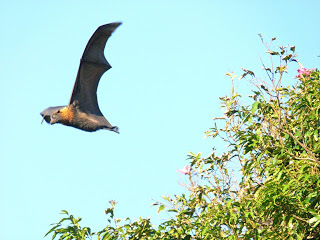 A fruit bat in flight at Sydney's Royal Botanic Gardens, Australia (© Daniel Vianna/Wikipedia –
CC BY-SA 3.0 licence
)
A fruit bat in flight at Sydney's Royal Botanic Gardens, Australia (© Daniel Vianna/Wikipedia –
CC BY-SA 3.0 licence
)But when he brushes up against a screen,We are afraid of what our eyes have seen:
For something is amiss or out of placeWhen mice with wings can wear a human face.
Theodore Roethke – ‘The Bat’
The following article of mine was originally published by Fortean Times in its April 1997 issue (and is reprinted in unchanged form below). Yet despite the initially encouraging research documented in it, the passage of time following its publication did not prove kind to the flying primates hypothesis. In more recent years, sufficient evidence against its veracity as obtained via comparative DNA analysis with primates, mega-bats, and micro-bats has been proffered for it to be largely (though not entirely) discounted nowadays by mainstream workers. Nevertheless, even though the notion of fruit bats as our winged cousins may have been grounded, zoologically speaking it remains of undeniable historical interest, and was such a charming novelty while it lasted that I couldn’t resist recalling it on ShukerNature as part of my occasional 'Out of the Archives' series – so here it is.
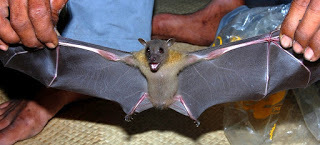 The minute fruit bat Cynopterus minutus with outstretched wings (© Wibowo Djatmiko/Wikipedia - CC BY-SA 3.0 licence)
The minute fruit bat Cynopterus minutus with outstretched wings (© Wibowo Djatmiko/Wikipedia - CC BY-SA 3.0 licence)The fortean literature contains reports of some exceedingly bizarre entities, but few are any stranger than the various bat-winged humanoids spasmodically reported from certain corners of the world. These include such aerial anomalies as the Vietnamese 'bat-woman' soberly described by three American Marines in 1969, the child-abducting orang bati from the Indonesian island of Seram, and the letayuschiy chelovek ('flying human') reputedly frequenting the enormous taiga forest within far-eastern Russia's Primorskiy Kray Territory (click here for further details).
Zoologists have traditionally averted their eyes from such heretical horrors as these, but in a classic 'fact is stranger than fiction' scenario, a remarkable evolutionary theory has lately re-emerged that unites humans and bats in a wholly unexpected evolutionary manner.
FLYING FOXES AS WINGED PRIMATES?
As far back as 1910, W.K. Gregory proposed that bats were closely related to primates - the order of mammals containing the lemurs, monkeys, apes, and humans. More recently, Dr Alan Walker revealed that dental features of a supposed fossil primate christened Propotto leakeyi in 1967 by American zoologist Prof. George Gaylord Simpson indicated that it was not a primate at all, but actually a species of fruit bat.
In 1986, however, Queensland University neurobiologist Dr John D. Pettigrew took this whole issue of apparent bat-primate affinity one very significant step further, by providing thought-provoking evidence for believing that the fruit bats may be more than just relatives of primates - that, in reality, these winged mammals are primates!
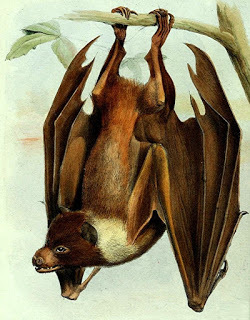 Chuuk flying fox Pteropus insularis, PZSL 1882 (public domain)
Chuuk flying fox Pteropus insularis, PZSL 1882 (public domain)All species of bat are traditionally grouped together within the taxonomic order of mammals known as Chiroptera. Within that order, however, they are split into two well-defined suborders. The fruit bats or flying foxes belong to the suborder Megachiroptera ('big bats'), and are therefore colloquially termed mega-bats. All of the other bats belong to the second suborder, Microchiroptera ('small bats'), and hence are termed micro-bats.
MACRO-BATS AND MICRO-BATS – NOT SEEING EYE TO EYE?
As a neurobiologist, Dr Pettigrew had been interested in determining the degree of similarity between the nervous systems of mega-bats and micro-bats. In particular, he sought to compare the pattern of connections linking the retina of the eyes with a portion of the mid-brain called the tectum, or superior colliculus. He used specimens of three Pteropus species of fruit bat to represent the mega-bats. And to obtain the most effective comparison with these, he chose for his micro-bat representatives some specimens of the Australian ghost bat Macroderma gigas - one of the world's largest micro-bats. Ideally suited for this purpose because its visual system is better developed than that of many other micro-bats, it has large eyes like those of fruit bats, and retinas with a similar positional arrangement.
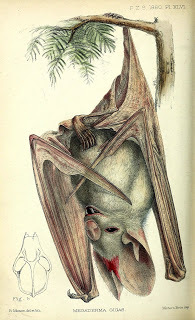 The Australian ghost bat, a giant species of micro-bat (public domain)
The Australian ghost bat, a giant species of micro-bat (public domain)Pettigrew's examination of all of these specimens revealed that the pattern of retinotectal neural connections was very different between mega-bats and micro-bats, but far more important was the precise manner in which they differed - providing a radically new insight not merely into bat evolution but also into the family tree of humanity.
Reporting his remarkable findings in 1986, Pettigrew announced that the retinotectal pattern of connections in fruit bats was very similar to the highly-advanced version possessed by primates. That fact was made even more astounding by the knowledge that until this discovery, the primate pattern had been unique. In other words, it had unambiguously distinguished primates not only from all other mammals (including the micro-bats) but also from all other vertebrates, i.e. fishes, amphibians, reptiles, and birds - all of which have a quite different, more primitive pattern. Suddenly, the fruit bats were in taxonomic turmoil.
NOT SUCH A FLIGHT OF FANCY?
Until now, the fact that micro-bats and mega-bats all possessed wings and were capable of controlled flight had been considered sufficient proof that they were directly related, because it seemed unlikely that true flight could have evolved in two totally independent groups of mammals. Gliding, via extensible membranes of skin, had evolved several times (e.g. in the scaly-tail rodents – click here for some cryptozoological connections); the 'flying' squirrels; three different groups of 'flying' marsupial phalanger; and the peculiar colugos or 'flying lemurs' – click here ), but this did not require such anatomical specialisations as the evolution of bona fide, flapping wings for true flight.
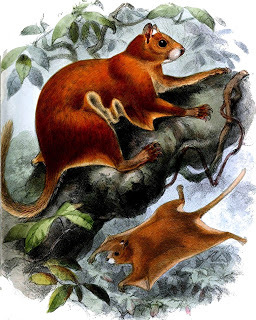 Scaly-tails, one species of which is locally dubbed the flying jackal (public domain)
Scaly-tails, one species of which is locally dubbed the flying jackal (public domain)Yet it seemed even less likely that the advanced retinotectal pathway displayed by primates could have evolved wholly independently in fruit bats.
In short, by exhibiting the latter organisation of neural connections, fruit bats now provided persuasive reasons for zoologists to consider seriously the quite extraordinary possibility that these winged mammals were not bats at all, in the sense of being relatives of the micro-bats. Instead, they were nothing less than flying primates!
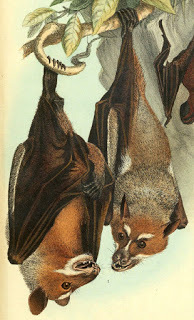 Wallace's fruit bats Styloctenium wallacei, 1896 (public domain)
Wallace's fruit bats Styloctenium wallacei, 1896 (public domain)Moreover, as Pettigrew noted in his paper, even the wings of mega-bats and micro-bats are not as similar as commonly thought. On the contrary, they show certain consistent skeletal differences, which point once again to separate evolutionary lines. And even that is not all - thanks to Dermoptera, that tiny taxonomic order of gliding mammals known somewhat haplessly as the flying lemurs (bearing in mind that they are not lemurs, and do not fly!) or, more suitably, as the colugos.
For by combining previously-disclosed similarities in blood proteins between the primates and the flying lemurs with the structural and neural homology apparent between the flying lemurs' gliding membranes and the wings of the mega-bats, extra evidence is obtained for a direct evolutionary link between fruit bats, primates, andthe flying lemurs - thus resurrecting another possibility that had been suggested by researchers in the past.
FACING UP TO THE FACTS
One of the most familiar external differences between mega-bats and micro-bats is the basic shape of their face.
 The remarkably lemur-like face of a Pteropus fruit bat (public domain)
The remarkably lemur-like face of a Pteropus fruit bat (public domain)Whereas the face of most fruit bats is surprisingly vulpine (hence ‘flying fox’) or even lemurine, in many micro-bats it is flatter in shape - though in some species, evolution has superimposed upon this shape all manner of grotesque flaps and projections.
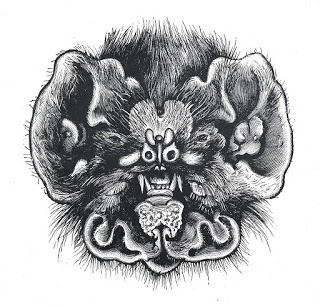 The uniquely grotesque face of the aptly-named Antillean ghost-faced bat Mormoops blainvillii, a species of micro-bat native to the West Indies (public domain)
The uniquely grotesque face of the aptly-named Antillean ghost-faced bat Mormoops blainvillii, a species of micro-bat native to the West Indies (public domain)The lemur-like shape exhibited by the face of many fruit bats has traditionally been dismissed as evolutionary convergence, engendered merely by these two mammalian groups' comparable frugivorous tendencies.
Judging from Pettigrew's revelations, however, there may now be good reason to believe that such a similarity is a manifestation of a genuine taxonomic relationship between lemurs and fruit bats. The faces of the flying lemurs are also very lemurine (hence their name), which ties in with the above-noted serological evidence for a direct, flying lemur-primate link.
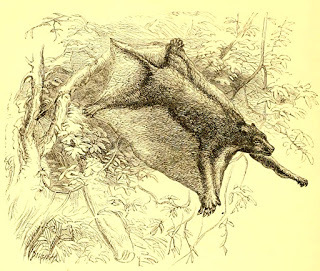 A colugo or flying lemur, again presenting a very lemurine face (hence its name) (public domain)
A colugo or flying lemur, again presenting a very lemurine face (hence its name) (public domain)Thought-provoking indeed is the evidence for believing that fruit bats are legitimate, albeit aerially-modified, offshoots from the fundamental family tree of the primates. As Pettigrew pointed out, it is highly implausible that the reverse theory is true (i.e. that the fruit bats gave rise to the primates), because fruit bats seem to be relatively recent species, first evolving long after the primate link had emerged.
EVIDENCE FOR AND AGAINST FLYING PRIMATES
Inevitably, no theory as radical as one implying primate parentage for the fruit bats will remain unchallenged for very long. In 1992, for instance, molecular biologist Dr Wendy Bailey and two other colleagues from Detroit's Wayne State University School of Medicine announced that DNA analysis of the epsilon(e)-globin gene of both groups of bats, primates, and a selection of other mammals implies that the two bat groups are more closely related to one another than either is to any other mammalian group. This finding would therefore seem to support the traditional bat classification., but as noted by proponents of Pettigrew's ideas, it does not explain the extraordinary development by fruit bats of the primates' diagnostic visual pathway. Consequently, this tantalising physiological riddle currently remains unanswered.
Moreover, in a comparative immunological study whose results were published during 1994, Drs Arnd Schreiber, Doris Erker, and Klausdieter Bauer from Heidelberg University showed that proteins in the blood serum of fruit bats and primates share enough features to suggest a close taxonomic relationship between these two mammalian groups after all - thus bringing this continuing controversy full circle.
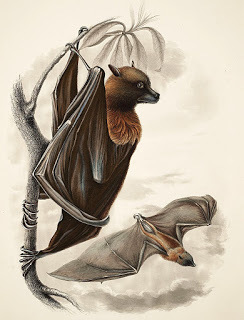 Samoan fruit bats Pteropus samoensis, 1858 (public domain)
Samoan fruit bats Pteropus samoensis, 1858 (public domain)Many primitive tribes believe that fruit bats are the spirits of their long-departed ancestors. In view of the fascinating disclosures reported here, these tribes could be closer to the truth than they realise!
This ShukerNature blog article is excerpted from my book Karl Shuker's Alien Zoo – a massive compendium of my Alien Zoo cryptozoological news reports and my longer Lost Ark cryptozoological articles that have been published in Fortean Times since the late 1990s.

Published on February 24, 2017 20:15
Karl Shuker's Blog
- Karl Shuker's profile
- 45 followers
Karl Shuker isn't a Goodreads Author
(yet),
but they
do have a blog,
so here are some recent posts imported from
their feed.



